








Royal GD is a partner within the animal health industry worldwide, performing in vivo, in vitro and field studies. We conduct safety and efficacy studies on veterinary biologicals and pharmaceuticals in compliance with the OECD principles of Good Laboratory Practice (GLP). Our portfolio includes, but is not limited to: • Safety and efficacy studies of veterinary biologicals and pharmaceuticals; • Studies to obtain vaccine or challenge-strain candidates; • Quality control tests on final products; • Development of models to demonstrate the efficacy or safety of veterinary biologicals and pharmaceuticals; • Surveys on the prevalence of (emerging) infectious diseases/agents. Get in touch and plan a meet up with our account managers and research project team: support@gdanimalhealth.com


Mark A. Barker

Beatriz Romao beatriz@senglobalcoms.com
Virginia Toteva virginia@senglobalcoms.com
DESIGNER
Jana Sukenikova www.fanahshapeless.com
Jerome D’Souza info@senglobalcoms.com
ADMINISTRATOR
Jessica Chapman jessica@senglobalcoms.com
FRONT COVER © istockphoto
PUBLISHED BY
Senglobal Ltd. Unit 5.02, E1 Studios, 7 Whitechapel Road, E1 1DU, United Kingdom
Tel: +44 (0) 2045417569 Email: info@senglobalcoms.com www.international-animalhealth.com
International Animal Health Journal – ISSN 2752-7697 is published quarterly by Senglobal Ltd.
Globally, endemic, and emergent disease risks persist as significant challenges to human and animal health. Rural livestock farming communities in low- and middleincome countries are disproportionately affected by zoonoses and animal diseases due to poverty and concomitant poorly available health and veterinary services. Dr. Alison Z. Pyatt, Dr. Stephen C. Mansbridge and Dr. Vetja Haakuria explain why a One Health approach to tackling zoonosis is now broadly advocated and a successful strategy requires sector stakeholder recognition, inclusion, and engagement to ensure a holistic response to a complex problem.
Openness and transparency are key values of the European society and research. Research may unfortunately still involve – at certain stages – the testing of animals for academic or regulatory purposes (fundamental biological research, pharmaceuticals, immunologicals, infectiology, surgery, medical devices, chemicals, environment, food and feed). Since 2010 protection of animals which are to be used for scientific purposes is commonly agreed upon and requested legally in Europe as per Directive 2010/63/EU on the protection of animals used for scientific purposes (latest consolidation in 2019). Animal testing on cosmetics and the marketing of such products has even been prohibited in the EU. Regine Schreiner and Regina Ohlmann at Feed and Additives explore more about the transparency regulation.
Mycoplasma bovis is more widespread than previously thought, affecting beef and dairy cattle across the country, according to results from a new surveillance programme. And it can be easily detected through bulk milk serology testing, which the results suggest may be more sensitive than other forms of testing. Ruth Wills at Agri-hub explains how to tackle widespread Mycoplasma bovis.
The opinions and views expressed by the authors in this journal are not necessarily those of the Editor or the Publisher. Please note that although care is taken in the preparation of this publication, the Editor and the Publisher are not responsible for opinions, views, and inaccuracies in the articles. Great care is taken concerning artwork supplied, but the Publisher cannot be held responsible for any loss or damage incurred. This publication is protected by copyright.
Volume 9 Issue 4 Winter 2022
Senglobal Ltd.
Frog farming, or raniculture, encompasses activities related to frog production, including maintenance, reproduction and breeding, as well as being part of the aquaculture industry. The objectives of raniculture can be commercial, such as human feeding (frog legs), animal feeding, or non-commercial such as repopulation with threatened species. Jose Barrio and Fabián Simón at Grenoucerie investigate why an interdisciplinary approach is needed in frog farming to replace wild-caughts that damage natural populations, whilst developing captive breeding programmes to ensure species survival.
We are working for a society that cares for the wellbeing of its animals like never before. As humans, we are facing
global challenges in physical, mental and environmental health. Dr. Ramiro Cabral at Elanco Animal Health International demonstrates why he believes that healthier animals are the key to helping us unlock today’s most critical global challenges, solving problems like malnourishment, anxiety and resource scarcity.
Quarantine is a key issue when dealing with ornamental fish. The rapid spread of pathogens through the water alongside a less advanced immune system makes a correct "biosecurity plan" mandatory. Jose Barrio at Grenoucerie discusses the importance of quarantine facilities for fish in aquariums.
Corrosion can severely affect tablet compression tooling used in the production of animal medicine if it is not addressed effectively. It can delay production, reduce efficiency, and cause contamination problems. There are several reasons why corrosion can occur, and although challenging, it can be resolved with a combination of the correct tool steel selection, coating or treatment and maintenance procedures. Liam Preston at I Holland outlines how to protect tooling from corrosion to enhance tablet production in animal health.
Feed can account for up to 70% of operating costs for poultry producers. Unfortunately, issues with climate
change, international conflict and supply chain challenges are only adding to this. This has left many producers looking for alternative and innovative solutions that will not only help lessen this financial burden but also help improve animal performance. Marquisha Paul at Alltech, shows ways to improve feed digestibility and nutrient breakdown with exogenous enzymes.
The circular economy, or circularity of a system, is an intentional effort to design out waste and pollution, keep products and materials in use and regenerate natural systems. Lara Moody at Institute for Feed Education and Research, and Anton van den Brink at European Feed Manufacturer’s Association address the role a circularity metric could have in assessing and valuing sustainability efforts for the animal food supply chain and consider measurement and assessment limitations that exist, which restrict the industry’s potential to accurately account for its environmental impact and role in a circular economy.

Preservation of natural habitats of wildlife must be undertaken and injudicious cutting or burning of forests must be prohibited. Human access for livestock grazing, hunting or other recreational activities must be minimised in the buffer zone and strictly restricted in core forest regions. Hina Malik at Guru Angad Dev Veterinary and Animal Sciences University examines how humans have ruined the balance of the ecosystem and exploited flora and fauna for their own gain.

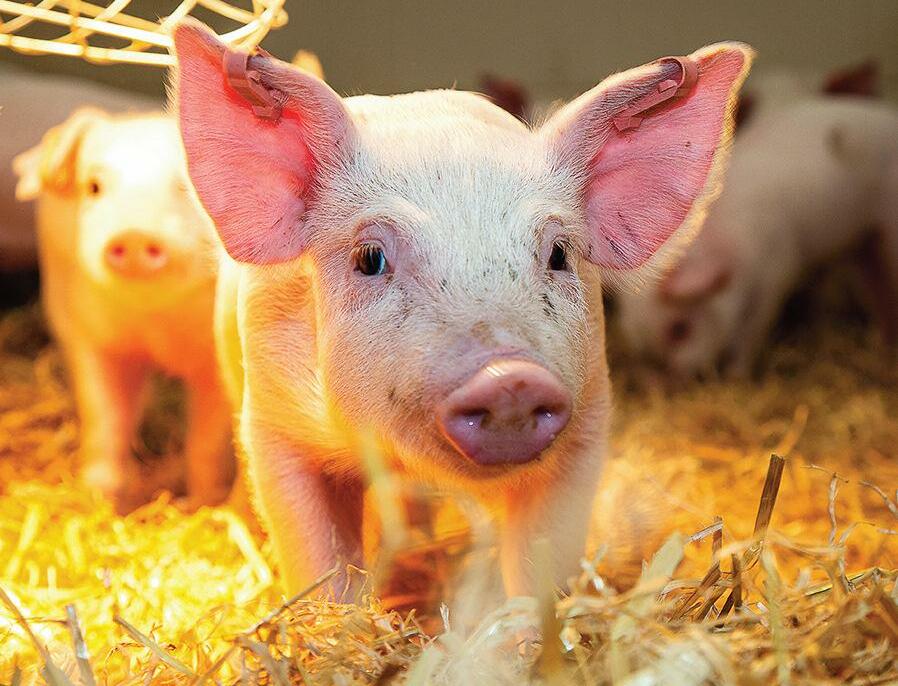


Welcome to the latest edition of the Journal. This year, 2022, has been turbulent in many areas including politics, conflicts and public health. As this edition of the Journal is being prepared, there are concerns over a number of infectious diseases including COVID-19. However, this is not the only disease for health professionals to focus on. Respiratory syncytial virus (RSV) and diphtheria have raised concerns, at least in the UK while infections and some fatalities caused by Group A Streptococcus (GAS; strep A) are currently a major public health issue. These diseases are notable in their ease (or relative ease) of transmission from human to human. There is another group of infectious diseases which are also notable because their transmission is from animal to human. These are the zoonotic diseases.
Zoonotic diseases are not restricted to any particular region or territory. They are found in low-, middle- and high-income countries. People in countries such as the UK are not used to considering the spread of a disease from animals to humans. It is probably not considered a major issue. In terms of numbers, this is probably correct but in terms of the severity of disease which might result it certainly is not true.
In the UK, the Health and Safety Executive (HSE) is responsible for occupational safety and health. HSE notes that in the UK, there are around 40 potential zoonotic diseases with over 300, 000 people potentially exposed. The diseases highlighted by HSE are varied. They include anthrax, bovine tuberculosis and leptospirosis (bacterial), avian influenza, orf, rabies and Q fever (viral), toxoplasmosis, giardiasis and hydatid disease (parasitic), ringworm (fungal) and Creutzfeldt-Jacob disease (CJD, prion). COVID-19 is considered to be a zoonotic disease which originated in bats and possibly spread to humans through an intermediate animal host.
So, why is a government agency responsible for occupational safety and health interested in zoonotic diseases? The answer is that for many of these diseases although certainly not all, humans are likely to be infected through their occupations and the major occupation affected is farming – agriculture. A small survey conducted by HSE showed a high prevalence of antibodies to Coxiella (Q fever), Chlamydia (psittacosis/ ovine chlamydiosis) and Toxoplasma (toxoplasmosis) in a UK farming population. Almost certainly, markers of other zoonotic diseases could have been found had they been investigated.
The UK enjoys modern farming practices and its population has good access to advanced medical and veterinary services. This is not the case in many countries where disease awareness
Amanda Burkardt, MSc, MBA – CEO of Nutripeutics Consulting
Germán W. Graff – Principal, Graff Global Ltd
my be lower and access to good medical and veterinary services may be restricted or simply not available.

One Health is a collaborative and interdisciplinary approach to health issues which recognises that the health of the human population is intimately connected to the health of animals and the health of the environment which they share. It covers a number of areas of concern including antimicrobial resistance, vector-borne diseases and water contamination. By their very nature, zoonotic diseases are a prime focus for a One Health approach. It is gaining recognition globally as an effective (and cost-effective) method of combatting diseases at the human-animal-environment interfaces and particularly in areas affected by poverty and poor veterinary and medical services. In this issue of the Journal, Drs Pyatt, Mansbridge and Haakuria explain the One Health tool for addressing the problems raised by zoonotic diseases.
I am certain that you will find their article interesting and though provoking. I am equally sure that you will enjoy the other fascinating articles in this edition.
Kevin Woodword,Managing Director, KNW Animal Health Consulting

Fereshteh Barei – Health Economist & Strategy Advisor, Founder of BioNowin Santé Avenue Association
Carel du Marchie Sarvaas Executive Director Health For Animals
Kimberly H. Chappell – Senior Research Scientist & Companion Animal Product Development Elanco Animal Health
Dr. Sam Al-Murrani – Chief Executive Officer Babylon Bioconsulting & Managing Director at Bimini LLC
Sven Buckingham – Buckingham QA Consultancy Ltd.

Dan Peizer – Director Animal Health at Catalent Pharma Solutions
Dawn Howard – Chief Executive of the National Office of Animal Health (NOAH)
Jean Szkotnicki – President of the Canadian Animal Health Institute (CAHI)
Dr. Kevin Woodward – Managing Director KNW Animal Health Consulting
Norbert Mencke – VP Global Communications & Public Affairs Bayer Animal Health GmbH


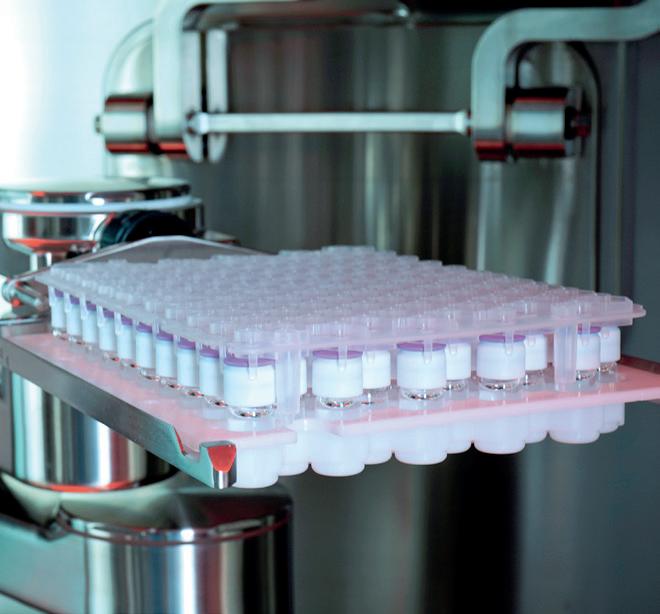

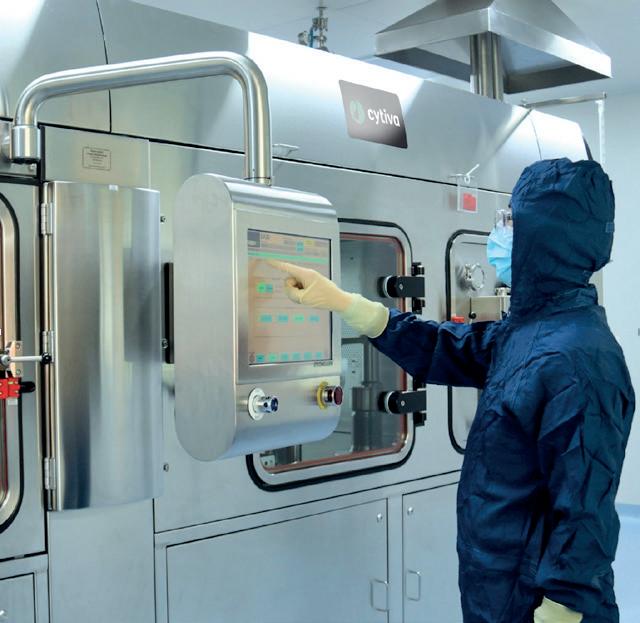

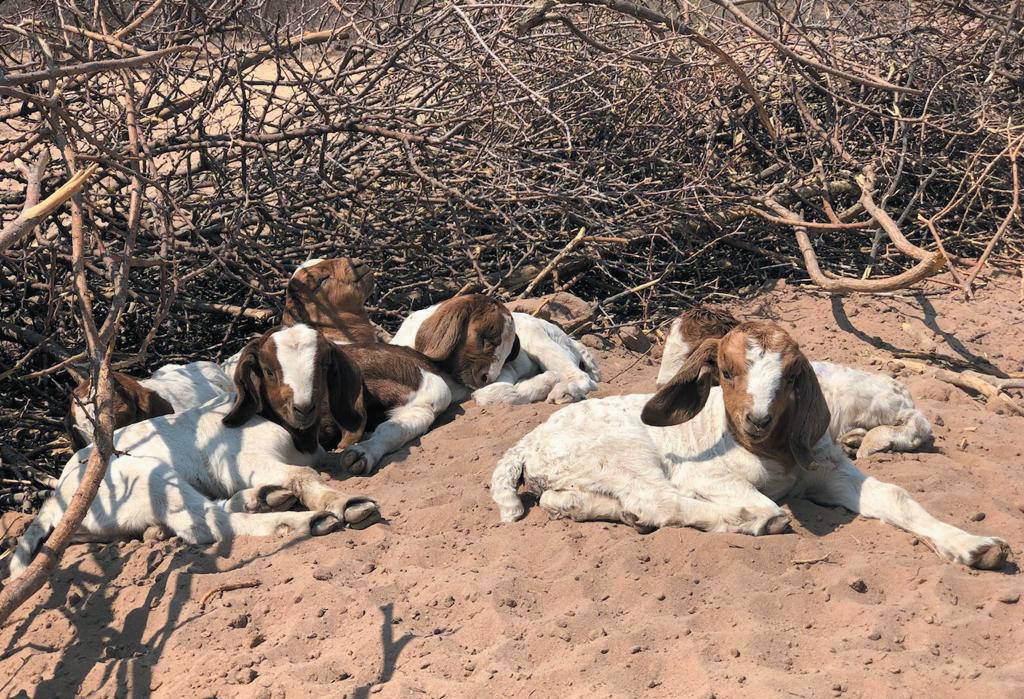
Globally, endemic and emergent disease risks persist as significant challenges to human and animal health. Rural livestock farming communities in low- and middle-income countries (LMICs) are disproportionately affected by zoonoses and animal diseases due to poverty and concomitant poorly-available health and veterinary services. In countries heavily reliant on animal production for socio-economic stability, the impact of zoonotic disease is devastating. A One Health approach to tackling zoonosis is now broadly advocated and a successful strategy requires sector stakeholder recognition, inclusion, and engagement to ensure a holistic response to a complex problem.
Livestock farming is essential to the livelihoods of many rural Africans1, with lives immersed in animal production for self-sufficiency, and increasingly robust home and export markets. Pastoralist systems are prevalent in arid regions where inconsistent rainfall prohibits effective crop production, promoting animal farming as a dependable source of income2 As 66% of Africa’s land expanse is used to graze animals, pastoralism is a vital part of the African economy. Animals also fulfil a spiritual and cultural role in rural populations through ritualised practices which enhance self-knowledge and identity. Livestock production contributes to almost half of the global agricultural gross domestic product (GDP)3, yet poverty in the Sub-Saharan African farmer community is widespread and persistent.
with a target annual delivery of 5,000 tonnes. The Kenyan Meat Commission routinely exports to the Middle East and North Africa (MENA) region, confirming globalisation of the animal products export market. This sector makes an increasingly important contribution to the national economy of many SubSaharan African nations, but in districts where commercial and subsistence farming systems run in close proximity, and disease risks from wildlife persist, then securing livestock health is challenging. Low livestock productivity is attributed to weak production systems and poor animal health4,5, often linked to restricted access to comprehensive animal health services.
Millions of lives are affected on a global basis daily by zoonotic disease. The outbreak of COVID-19 brings a stark reminder of the ongoing risk to human health, and modelling of worldwide disease outbreaks indicates that around threequarters of emergent human disease is zoonotic in origin3 Endemic zoonoses have a devastating effect on human health and livelihoods; as well as animal health, welfare, and production. Rural communities in LMICs are the most vulnerable to zoonotic disease6 due to the close residence of people with animals and dependence on livestock farming, traditional food consumption practices, and limited access to human and animal health services3,7. Endemic zoonotic disease outbreaks continue to be problematic and since 2000, a number of epidemic zoonoses not previously known have been widely reported (Table 1).
In some regions, the international meat export markets have surged, with growing demand from the EU and Norway for meat products from Botswana, Namibia, Swaziland, and South Africa. After almost twenty years of lobbying and successful introduction of strict biosecurity measures, in 2020, the Namibian state-owned Meat Corporation of Namibia (MeatCo) entered the American meat market, with an initial shipment of 25 tonnes of beef to Philadelphia. The approval will enable MeatCo to deliver 860 tonnes in the first trading year,

The World Health Organisation (WHO) defines One Health as “an approach to designing and implementing programmes, policies, legislation and research in which multiple sectors communicate and work together to achieve better public health outcomes”. Central to the success of a One Health approach is the engagement and collaboration of sector expertise and stakeholders working together for shared objectives. For the animal health sector, this can encompass a broad range of professionals and paraprofessionals, all of whom make a valid contribution.
Despite the recognised socio-economic importance and

Endemic Zoonotic Disease Risks
Anthrax
Epidemic zoonoses not previously known before 2000
Severe Acute Respiratory Syndrome (SARS)
Brucellosis Middle-East Respiratory Syndrome (MERS)
Echinococcosis/ hydatidosis COVID-19
Mycobacterium tuberculosis
Rabies
Rift Valley Fever
Campylobacteriosis
Porcine cysticercosis
Q fever
Salmonellosis
Trypanosomiasis
West Nile Fever
Avian flu (H5N1)
Swine flu (H1N1)
Table 1. Current Global Endemic and Emergent Zoonotic Diseases Risks
widespread use of livestock farming in rural Sub-Saharan Africa, farmer access to veterinary services and medicines is often inadequate. The critical risks to the livestock farming sector are recognised as follows: failing animal health status; non-compliance of infrastructure; lack of preventative support and advice on matters of animal health, and the subsequent decline in animal production8. Risk factors are compounded as pastoralist farming communities are typically poor and have limited access to animal health resources including education and medicines6,8
Low numbers of veterinarians and veterinary paraprofessionals (with practitioners often required to cover a broad geographical expanse), declining animal health services (due to reduced government capacity), and limited farmer access to agri-merchant retail outlets all severely impact farmer ability to source veterinary services, veterinary advice and guidance, and safe veterinary medicinal products. In the absence of professional animal health advice, rural farmers will draw on their previous experiences, ethnoveterinary practice or tacit knowledge. Such findings are reflected in livestock farming practice in Tanzania, Ghana, Kenya, Zambia and Zimbabwe9,10. Insufficiencies in the availability of education and advice to farmers is known to be associated with poor access to veterinarians. Limitations to animal health services are known to heighten the risk from zoonotic disease7 and potentially the development of emergent zoonoses. Informed and educated farmers are better placed to recognise disease in their livestock and to understand the risk from zoonoses. Consequently, farmers who are able to access veterinary guidance and safe veterinary medicinal products are better positioned to initiate measures to enhance food security and concurrently veterinary public health. Simultaneously, they improve animal health/welfare and production to secure their own livelihoods. Farmers would be better equipped to reduce the risk of zoonosis and to safeguard public health in the broader sense, such as slowing the development of antimicrobial resistance. Linking animal health service providers to agricultural merchants can increase farmer access to animal health services, helping to reduce animal mortality, and enhance production and farming profitability. Importantly, maintenance of animal
health has concurrent positive effects of minimising the risk of zoonotic disease transfer. Unfortunately, training for veterinary medicine stockists in Sub-Saharan African rural farming regions has been found to be variable10,11 and employees can be under pressure to stock and sell certain products.
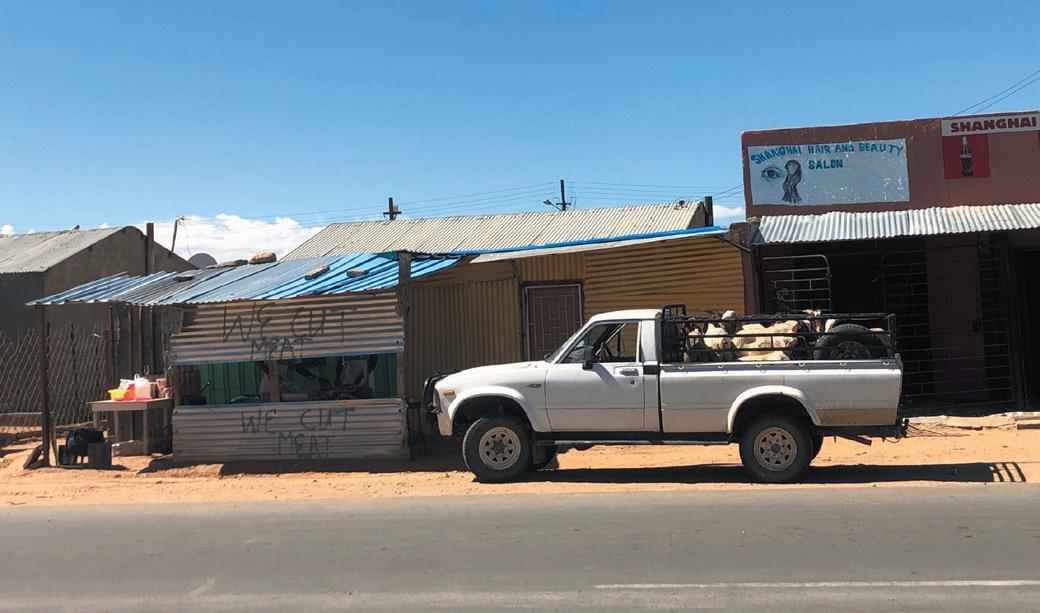
Outreach, farmer education, and enhanced communication from animal health services are all recognised as key success factors; but without readily available access to veterinarians and services, how may this be achieved?
Traditional meat market selling
The general international consensus on zoonotic disease control is that a One Health approach is often required. The interlocking nature of human, animal, and environmental factors is broadly accepted as the key to health across all three spheres. Fundamentally, a successful One Health approach to livestock farming requires all core stakeholders to be informed, engaged, and active in the quest for disease prevention, management and resolution. Core stakeholders to the rural African livestock sector include veterinarians, allied animal health practitioners such as veterinary paraprofessionals, farmers themselves, and arguably the interconnecting pharmaceutical professional the veterinary pharmacist.
Stakeholder Contribution

Stakeholders may be defined as any individual or group that is or should be involved in preventing or managing a health threat at the human-animal-environment interface. It should also include those who are impacted by such a health threat, in this instance the farming community. Engagement of the identified stakeholders is a crucial component of the One Health approach and working towards successful solutions to zoonotic disease risk. Many nations advocate the development of a vet-led team approach to the provision of veterinary health services; incorporating a broad range of allied animal veterinarian-led team such as veterinary nurses and technicians, nutritionists, reproductive technologists, and animal medicine advisers. This model seeks to delegate tasks to specialist professionals under veterinary direction. In LMICs where access to veterinarians is limited, vet technicians, animal health technicians or community animal health workers (CAHWs) are a veterinarian replacement, rather than an accompaniment to a broader team effort.
In pastoral regions, services provided by CAHWs have developed in direct response to inadequate veterinary health services and veterinarians. CAHWs are deeply rooted in the community, and correspondingly are highly trusted by rural farmers12, aiding the successful communication of advice and guidance. Yet they continue to face challenges stemming from insufficient veterinary medicine regulation (safe usage, dosage, route of administration and disposal) and inadequate staff training.
Agri-merchant outlets are commonly the core source of veterinary medicine supply. Appropriate retail staff training is proposed as a tool to encourage rational and correct medicine dispensing process and procedures. Studies corroborate training with improved quality of advice and information provided to clients during dispensing of veterinary medicines13,14,15. Recent NGO initiatives have clearly determined the positive impact on animal health and welfare from training and education programmes for agri-merchant retail staff16 . This perhaps indicates a broader role for the veterinary pharmaceutical sector in facilitating effective and accessible training platforms for veterinary medicine stockists.
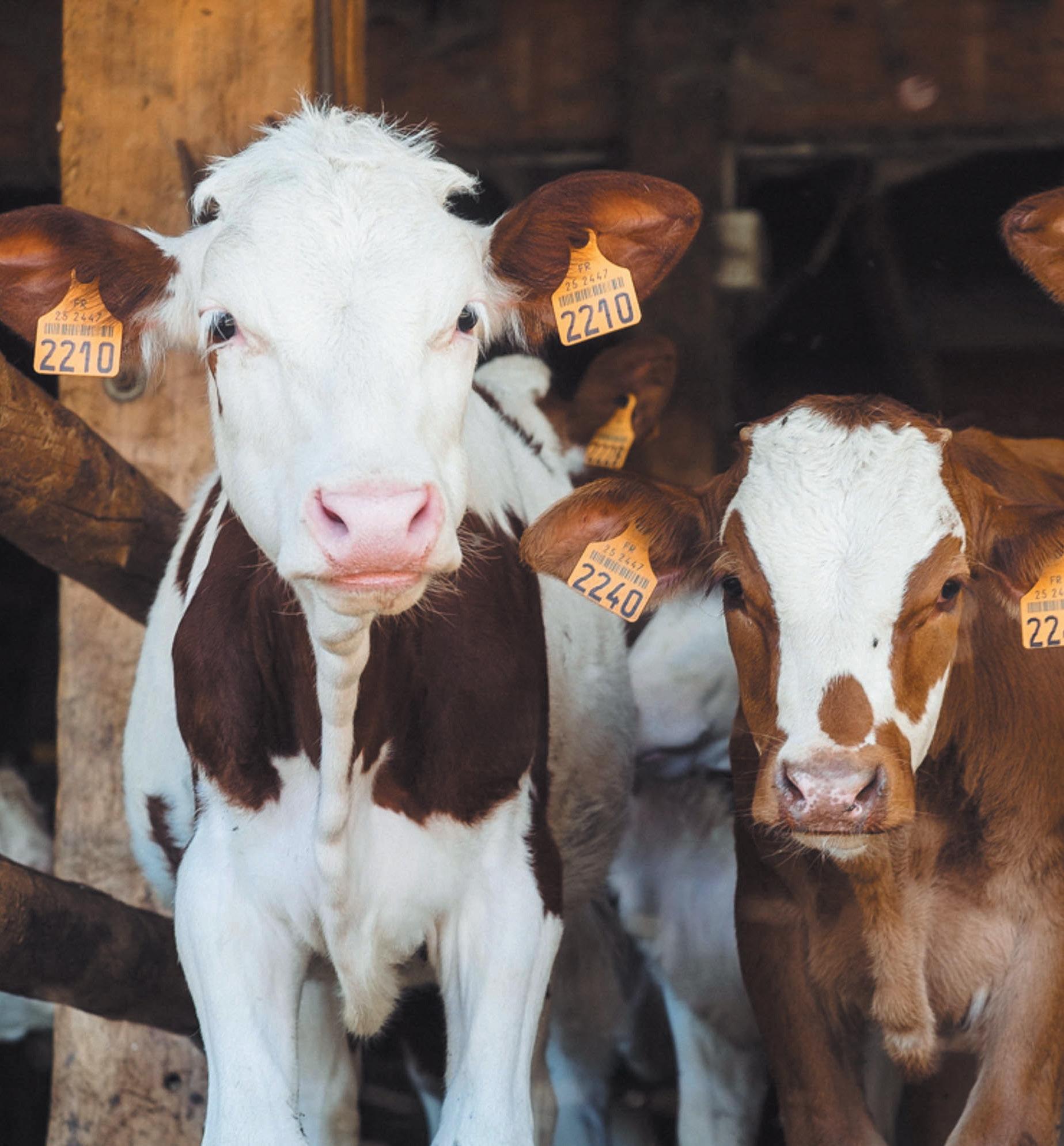
Recent years have seen the comprehensive extension and
expansion of the pharmacist role into matters of broader public health incorporating the overlap between human and animal health. Indeed, the professional discipline of veterinary pharmacy is now established and generally well accepted. As public-facing and accessible professionals, pharmacists (with the appropriate training) are extremely well-placed to provide advice and guidance on veterinary medicines practice. This is not to suggest a replacement to veterinarian services but as an additional professional practitioner leveraging accessibility to support the farming community through a One Health approach. In rural regions, where a paucity of veterinarians and animal health technicians is distinctly problematic, the veterinary pharmacy role could include veterinary public health, ensuring safe supply of veterinary medicines, as well as providing advice on correct use, storage and disposal,

pharmacovigilance, and information on zoonoses prevention and control. In LMICs, the community-based cadre is wellpositioned to extend veterinary pharmaceutical services to rural communities. Trained in pharmaceutics, community pharmacists are embedded within rural communities, and are recognised as established healthcare practitioners within the community. As the only health professional able to bridge both human and veterinary medicine, the veterinary pharmacist could serve to be the interlocking professional to secure interdisciplinary health.
In summary, the risks to human and animal health from endemic and emergent zoonoses will persist in the absence of accessible veterinary services, advice and guidance, and a secure supply chain for veterinary medicinal products. Risk to human health is both localised and international, as we have experienced in the recent outbreaks of SARS, MERS, and COVID-19. In regions where the demand for veterinarians outstrips supply, contributions from allied veterinary paraprofessionals and others, such as a veterinary pharmacy cadre, animal health technicians, and well-trained retail staff, may serve well to ameliorate insufficiencies.
1. McDermott, J., Staal, S., Freeman, A., Herrero,M., Van de Steeg, J. Sustaining intensification of smallholder livestock systems in the tropics. Livestock Sci. 2012; (130): 95–109.
2. Rota, A., Sperandini, S. Livestock and pastoralists. Livestock Thematic Papers: Tools for Project Design. International Fund for Agricultural Development, Rome, Italy. 2009; [Online] www. ifad. org/lrkm/factsheet/pastoralists. pdf. Visited 10.12.2020.
3. Grace D, Mutua F, Ochungo P, Kruska R, Jones K, Brierley L, Lapar L, Said M, Herrero M, Phuc PM, Thao NB, Akuku I and Ogutu F. 2012. Mapping of poverty and likely zoonoses hotspots. Zoonoses Project 4. Report to the UK Department for International Development. Nairobi, Kenya: ILRI
4. Oladele, O., Antwi, M., Kolawole, A. Incidence and Prevalence of Livestock Diseases along Border Villages of South Africa and Namibia. Journal of Animal and Veterinary Advances. 2013; 12 (2): pp.177-180.
5. Meat Board of Namibia. Meat Board of Namibia, Business Plan 2018-19. [On-line]. http://www.nammic.com.na/index.php/ library/send/23-annual-reports/244-ar2019 Visited 01.02.2021
6. Grace, D., Lindahl, J., Wanyoike, F., Bett, B., Randolph, T., Rich, K. Poor livestock keepers: ecosystem–poverty–health interactions. Philosophical Transactions of the Royal Society B: Biological Sciences. 2017; Jul 19;372(1725):20160166.
7. Cleaveland, S., Sharp, J., Abela-Ridder, B., Allan, K.J., Buza, J., Crump, J., Davis, A., Del Rio Vilas, V., De Glanville, W., Kazwala, R., Kibona, T. One Health contributions towards more effective and equitable approaches to health in low-and middleincome countries. Philosophical Transactions of the Royal Society B: Biological Sciences. 2017; Jul 19;372(1725):20160168.
8. Food and Agricultural Organization of the United Nations (FAO). Farming Systems and Poverty. [On-line]; .http:// www.fao.org/3/Y1860E/y1860e00.htm#TopOfPage. Visited 07.02.2020.
9. Caudell, M., Dorado-Garcia, A., Eckford, S., Creese, C., Byarugaba, D., Afakye, K., Chansa-Kabali, T., Fasina, F., Kabali, E., Kiambi, S., Kimani, T. Towards a bottom-up understanding of antimicrobial use and resistance on the farm: A knowledge, attitudes, and practices survey across livestock systems in five African countries. PLOS one. 2020; Jan 24; (1) 15.
10. Keyyu, J., Kyvsgaard, N., Kassuku, A., Willingham, A. Worm control practices and anthelmintic usage in traditional and dairy cattle farms in the southern highlands of Tanzania. Veterinary Parasitology. 2003; May 15;114(1):51-61.
11. Bett, B., Machila, N., Gathura, P., McDermott, J., Eisler, M. Characterisation of shops selling veterinary medicines in a
tsetse-infested area of Kenya. Preventive Veterinary Medicine. 2004. (63), 29–38.
12. Grasswitz, T., Leyland, T.J., Musiime, J., Owens, S., Sones, K. The veterinary pharmaceutical industry in Africa: a study of Kenya, Uganda and South Africa. African Union/Inter-African Bureau for Animal Resources (AU/IBAR), Nairobi, Kenya. 2004.
13. Higham, L.E., Ongeri, W., Asena, K., Thrusfield, M.V. Characterising and comparing animal-health services in the Rift Valley, Kenya: an exploratory analysis (part I). Tropical animal health and production. 2016; 48 (8):1621-1632.
14. Higham, L.E., Ongeri, W., Asena, K., Thrusfield, M.V. Characterising and comparing drug-dispensing practices at animal health outlets in the Rift Valley, Kenya. Tropical animal health and production. 2016; 48(8):1633-1643.
15. Haakuria, V.M., Pyatt, A.Z., Mansbridge, S.C., 2020. Exploration of veterinary service supply to rural farmers in Namibia: a One Health perspective. PAMJ-One Health, 2(17).
16. Brooke. https://www.thebrooke.org/our-work/one-healthbrooke Visited 10.01.2021

Dr. Pyatt works in the International Development and Training Office (Sub-Saharan Africa/ Asia) at the UK Veterinary Medicines Directorate. She holds a PhD in veterinary services at Hartpury University and Harper Adams University. Research interests are founded in stakeholder-centric and co-production of services in the global animal health and veterinary sectors. Dr. Pyatt is an international veterinary pharmacy consultant.
Email: azp@alisonpyatt.co.uk
Dr. Mansbridge is an accredited animal scientist and Senior Lecturer in Animal Science and Bioinformatics at Harper Adams University, UK. He holds a PhD in animal health and nutrition, working both in academia and industry to improve knowledge and applications for the animal and veterinary sectors.

Email: smansbridge@harper-adams.ac.uk

Dr. Haakuria is an academic and research consultant. He served as the Deputy Associate Dean in the School of Pharmacy, University of Namibia, where he lectured in the Pharmaceutics Department. A trained Veterinary Pharmacy specialist, his interests are in tackling global health challenges such as zoonoses and antimicrobial resistance across the One Health platform. He is currently leading projects to mainstream veterinary pharmacy as a profession to interface animal health and welfare, promoting sustainable animal production while safeguarding public health.
Email: haakuria@gmail.com


Openness and transparency are key values of the European society and research. Research may unfortunately still involve – at certain stages – the testing of animals for academic or regulatory purposes (fundamental biological research, pharmaceuticals, immunologicals, infectiology, surgery, medical devices, chemicals, environment, food and feed).
Since 2010 protection of animals which are to be used for scientific purposes is commonly agreed upon and requested legally in Europe as per Directive 2010/63/EU on the protection of animals used for scientific purposes (latest consolidation in 2019). Animal testing on cosmetics and the marketing of such products has even been prohibited in the EU.
The animal protection directive was amended by Regulation 2019/1010 with requirements for the reporting of statistical data on the use of animals for scientific purposes in the EU for which two implementing decisions have been adopted: Commission Implementing Decision 2012/707/EU and Commission Implementing Decision 2020/569/EU. So therefore, transparent data on animals used for scientific purposes in the EU is readily available.
Starting in 2014 the counting methods of the test animals have changed: Since then, all animals had to be counted at the beginning of each experiment and reported at the completion of the trial. With that some animals were counted one, two or even three times, like explained by the German Primate Centre (DPZ). With that it makes sense to start comparing numbers after 2014. Let us have a look and see how experimental animal numbers have developed over the last years (Graph 1: Number of all animals used in the EU (and Norway in 2018/2019) from 2015–2019). As you can clearly see the numbers of all animals used for testing, routine production, education, training purposes, research in the EU has increased and even so the numbers from Norway were included in the last two years, that might not be the only reason why numbers are not dropping as desired and anticipated. On the other hand on ALURES – European Commission (europa.eu) the latest numbers of the past 3 years are not published (yet).
The German BfR (Bundesamt für Risikobewertung) at least published the numbers from 2020 and compared them to 2019. They state that the numbers are clearly decreasing. In the year 2019 round about 3 million animals were used for scientific purposes and in the year 2020 only approx. 2,5 million.1 But in the published figures of the BfR, only the animals used for scientific purposes were listed. So the animals used for education, routine production, etc. are not included. Therefore again, it is questionable if the numbers are actually decreasing.
Apart from that, Europe and its member states are only a stagnant part of a rapidly growing global scientific community. It is highly questionable, whether animal experiments are not only outsourced to third countries, where animal welfare standards are lower and where competent authorities are less restrictive and faster with granting experimental permits. If this is the case, then even if the European animal numbers
were decreasing, this would still be a deterioration of the situation from the perspective of the animals used for scientific purposes. The animals themselves do not care where exactly they contribute to knowledge gain.
Graph 1: Number of all animals used in the EU (and Norway in 2018/2019) from 2015–2019
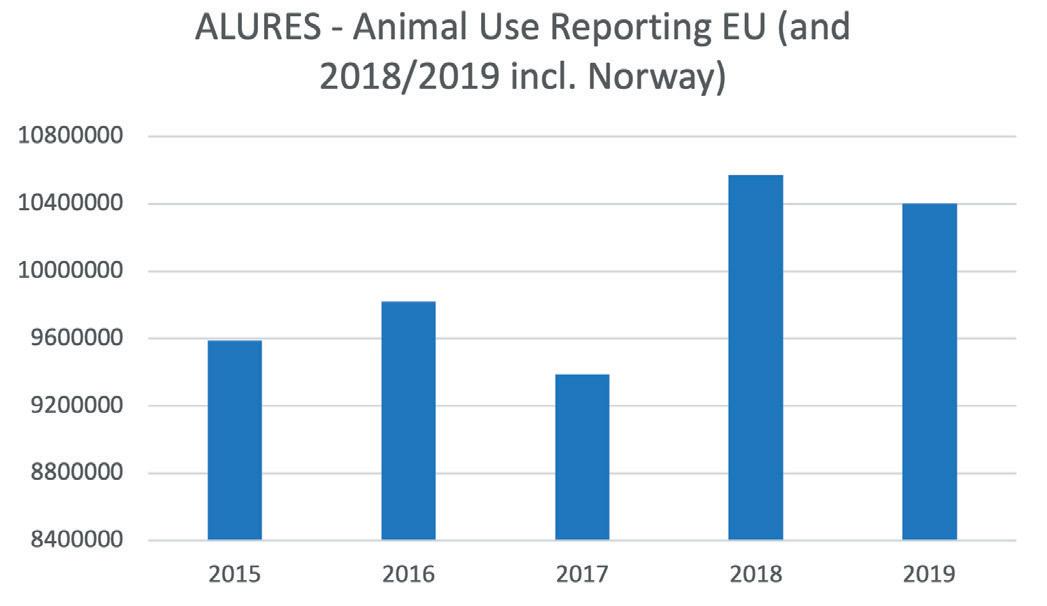
What exactly is regulated in Directive 2010/63/EU? It lays down the principles of the 3Rs (Replacement, Reduction, Refinement – Table 1). This main idea was developed over 50 years ago by Russell and Burch in their book „The Principles of Humane Experimental Technique“. European regulatory assessors, competent authorities, scientists and experimental animal care takers are all morally and legally dedicated to these three principles. Skilful product development and careful study design bear enormous benefits for the sponsor, the academic scientist and the animals simultaneously.
Replacement is obviously restricted by the replacement methods being actually „fit for the purpose“. In the end, scientists and regulatory bodies depend on obtaining „the same information“. The scientific community is working on this constantly and many grants are available for the development, the validation and verification of alternative methods (e.g. Felix-Wankel-Tierschutz-Forschungspreis (felix-wankel-forschungspreis.de)). The European Food safety Authority (EFSA) for example clearly states on its website:
“EFSA supports risk assessment approaches which minimise and refine the use of experimental animals (in-vivo testing) and that promote use of data derived from alternative approaches, where possible. These alternatives include lab tests in tubes, flasks, petri dishes, etc. (in vitro) or performed via computer simulation (in silico).”
Refinement is constantly developed by associations like FELASA (Federation of European Laboratory Animal Science Assessment) and commercial providers of experimental animals in their guidance documents (e.g. diet recommendations, enrichment recommendations etc.). When experiments with farm animals are to be carried out, the European farm animal welfare laws have of course also to be considered. The latter evolve constantly to higher levels.
But why does Reduction not seem to function? The answer to this question might be multifold and lies in the field of substance regulation:
• „long history of safe use“ is not an accepted principle for substance assessment. This may lead to the necessity of generation of a lot of new toxicological data especially for substances which have in the past been generally acknowledged as „safe“. For these substances, nobody in the past ever generated scientifically sound safety data. New tests may involve the use of new animals.
• „One substance one assessment“ is not consequently established. EFSA for example wants to see toxicological raw data, even if ECHA has assessed the substance already and robust summaries are publicly available. This may lead to the situation that experiments have to be duplicated.
• European consumer expectations: „I just want safe food“. The scientific approach to the very high standards of European food and feed safety requires hugh efforts by the food and feed industry and by the European Regulatory bodies. Testing also involves animal experiments.
• „Analytical overkill“. The possibilities of substance measurement have evolved in the last decades to brilliant methods with extraordinary possibilities of substance detection and quantification. Ironically this seems to rather lead to the impression of the European consumers that feed, food or pharmaceuticals are often contaminated. This puts public pressure on the EU regulatory bodies, who request more and more testing – partly also in animal models.
• Most grants for research projects are given for alternative methods, so mostly for the replacement strategy. It is hard to find promotions for good ideas to “only” reduce animal testing and it is even harder to get foundation if the ideas are coming from the industry. The BfR published some common grants for research in the field of alternative methods (https://www.bf3r.de/de/externe_ forschungsfoerderungsmoeglichkeiten_auf_dem_ gebiet_der_alternativmethoden-283335.html). Under all applicants those doing research at an university are usually preferred. Only the so called SET (“Stiftung zur Förderung von Ersatz- und Ergänzungsmethoden zur Einschränkung von Tierversuchen”) project promotes alternative and supplementary methods to limit animal testing. One of its main goal is to support “Scientific communication and international activities related to the 3Rs”.
Replacement It should be considered to do some kind of research without any animal testing – if possible with the alternative methods.
Reduction The animals used for testing should be reduced to that point that the outcome of the research is still obtaining the same information.
Refinement
The experiment shall be planned that the distress of the animals is at the lowest level and the welfare of the animals is at the highest level.
VISION: Reuse As seen under REACH: The Reuse of test results should be considered and possible at different levels in the field of research, authorisation
Table 1; 3Rs + Vision of Reuse
But which strategy out of this self-enforcing cycle could reduce the demand for animal testing systems? A vision would be to re-use study data packages for different regulatory purposes by making data sets ready to trade them in a transparent market. Results from similar substances could also be referred to by read-acrosses. Having a look at the REACH2 regulation from 2007 it is already requested by law
that the outcome of similar animal testings for the safety of chemicals need to be shared: „Adequate and reliable studies with animal experiments must not be repeated. Companies are also encouraged to share all data available in their possession.“
Professional data sharing could not only positively affect animal welfare and industry budgets, but is also highly sustainable.
Now that the transparency regulation (Regulation (EU) 2019/1381 on the transparency and sustainability of the EU risk assessment in the food chain for food and feed) is in place, it will become visible how many animals – here often farm animals – are used for authorizations of regulated feed and food products in Europe. Let us see what conclusions the public will draw from these figures and whether these new figures will show the same upward trend as the already transparent ALURES figures.
Safety comes at a cost. Let us find a way to reduce (refine, replace) and reuse our investments for better animal welfare and more sustainability.
1. Verwendung von Versuchstieren im Jahr 2020 (bf3r.de)

2. REACH – Registration, Evaluation, Authorisation and Restriction of Chemicals

Dr. Regine Schreiner graduated in veterinary medicine at the universitiy of Munich (LMU) in 2000. After completing her PhD degree, she worked as a scientist for different universities, a.o. as responsible veterinarian for the laboratory animals unit. In 2010 she started as a regulatory affairs manager in a veterinary CRO. She founded her own consultancy company in 2014: the „Feed and Additives GmbH“, which exclusively serves the feed industry. Regine and her constantly growing team support clients in Europe and the USA. Her main focuses are the regulation of product development, quality management, international trade and processing of feed and feed additives as well as animal nutrition science.
Email: regine.schreiner@feedandadditives.eu

Dr. Regina Ohlmann studied veterinary medicine in Munich. After finishing her PhD degree in Würzburg she worked as a veterinary practicioner in Germany and the USA for many years. Searching for new opportunities she started to work in the field of medical industries. She gained experience in sales, marketing and pharmacovigilance before joining the Feed and Additives GmbH team in 2017. As a scientist with special competence in feed and feed additives, regulatory affairs and feeding studies she supports customers around the globe.
Email: regina.ohlmann@feedandadditives.eu
Mycoplasma bovis is more widespread than previously thought, affecting beef and dairy cattle across the country, according to results from a new surveillance programme. And it can be easily detected through bulk milk serology testing, which the results suggest may be more sensitive than other forms of testing.
“For a few years, I have suspected that M. bovis is more prevalent than expected,” explains Graeme Fowlie, director of Meadows Vets in Aberdeenshire. “And from working with vets across the country taking part in the surveillance programme, it’s become clear that that is the case.” The results, from vet practices across England, Scotland, Wales and Northern Ireland, show that M. bovis is present in every region, in both beef and dairy herds. “It is probably present in your area, so you should be aware of it.”
The disease causes pneumonia, mastitis, swelling, sore joints and otitis, and can also be responsible for a range of chronic underlying health issues, which have a significant impact on welfare and productivity.

As part of the surveillance programme, vets were offered free M. bovis tests, regardless of whether herds were exhibiting signs of disease or not. Of the 41 farms from across the UK taking part, 18 tested positive, six were inconclusive or void,

and 17 were negative. But the results also revealed that some types of analysis were more sensitive than others.
Of the 25 blood tests, 52% were positive while 20% were inconclusive and 28% were negative – despite the fact that eight of those negative / inconclusive results were from farms with symptomatic animals. An interesting result was that the five bulk milk serology tests all came back positive. The 11 PCR tests – mainly of bulk milk samples – failed to show a single positive result.

Ben Pedley, Farm Clinical Director at Willows Farm Vets, Cheshire, says: “In the past two years we have found M. bovis on a number of farms after PCR testing lung samples taken post-mortem from pneumonia cases. Since diagnosing the infection, calf pneumonia on these units has been greatly reduced via management changes including specific vaccination programmes for Mycoplasma.”
Meadows Vets have found similar results to this study, says Mr. Fowlie. “We have been using blood tests on calves over five months old to screen herds. Dairies could also be screened via bulk milk serology. Sick animals can be identified with PCR testing of either nasal swabs, post mortem material, joint fluid or milk samples.”
Since he started using these tests two years ago, he’s returned more positive samples than in the previous 20 years.
The disease affects both young and adult cattle and poses a significant drain on beef and dairy farms as it causes pneumonia and mastitis, and other chronic underlying health conditions. Due to the nature of the disease, it is difficult to treat because it doesn’t respond to most antibiotics.
This makes a vaccine the most effective method of controlling it, as in this case prevention is better than cure. In a comparative case-study, the multi-strain vaccine licensed under the Cascade system demonstrated significant reductions in both weaned calf mortality and antibiotic usage.
The vaccine is a tool in the box for prevention of M. bovis, but there are other strategies which can be used on farm. Focusing on good building design and husbandry will help to limit the risk of any disease – so farmers should ensure good ventilation in housing and minimise stresses at challenging times like weaning.
Having good biosecurity will also help. If buying in stock, producers should select the herd of origin carefully to ensure there’s no history of clinical problems. They should buy as few animals as needed and from as few sources as possible. An antibody test could also be an option to check if stock are carriers before bringing them onto the farm.
It’s also important to be aware of the clinical presentation of the disease, and to follow up with diagnostics if there’s no response to control measures.

A study carried out in 2018 and 2019 looked at mortality and antimicrobial usage for 1582 calves born into eight herds in Scotland. It considered the efficacy of a new multi-strain vaccine imported from the US. Although the vaccine had proven effective after its introduction to the US market, this was the first time it was available in the UK.
Given the vaccine was new to the UK market, Mr. Fowlie at Meadows Vets organised a comparative case-study in Scottish dairy herds to see how it would work in a real farm environment. And the results were impressive: In total, weaned calf mortality fell from 5.8% pre-vaccination to 0.4% post-vaccination, whereas it remained relatively unchanged on control farms at 7.3–7.8%.
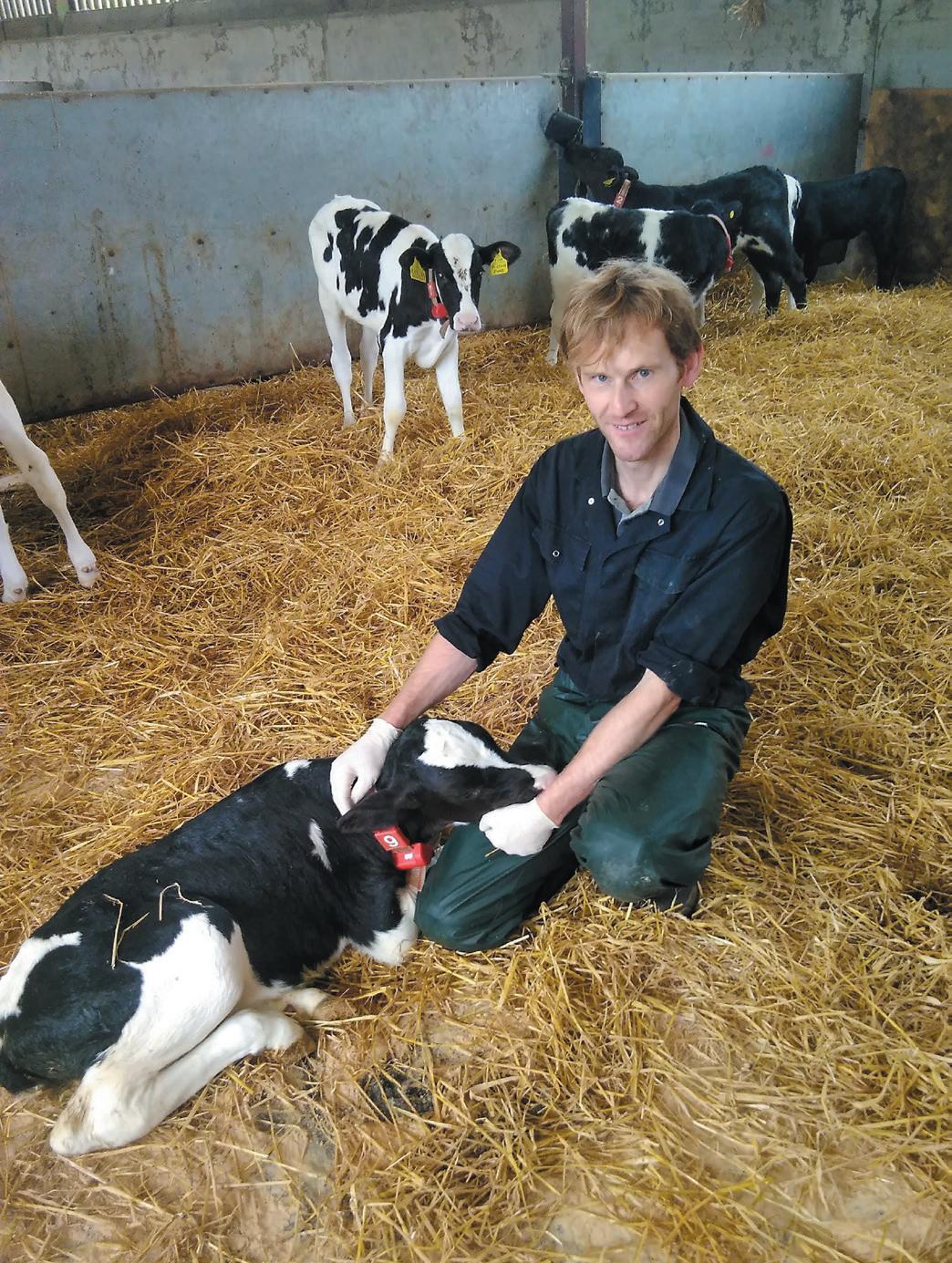
Due to inconsistent farm records, it was not possible to isolate mortality due to suspected pneumonia, so records for all mortality causes were used. Pre-weaning mortality increased slightly on treated farms, as one had an outbreak of cryptosporidium and two had problems with colostrum yield and quality. Overall calf mortality up to 200 days fell from 8.6% pre-vaccination to 4.3% afterwards, while it remained fairly static at 10.6–11.1% on control farms.
Antibiotic usage also dropped sharply among the trial farms, from an average of 116.9 PCU (population correction unit) per 100kg liveweight before vaccination to just 41.45 PCU/100kg afterwards. In contrast, usage on the control farms increased from 67.42 PCU/100kg to 78.99 over the same time period.
“We are suspicious some of these would have been false negative results when using traditional bacterial culture testing, which we know is less sensitive.
“One of the biggest problems with M. bovis is that it’s very hard to treat – it doesn’t respond to many common antibiotics, so prevention is much better than cure,” says Mr. Fowlie. “That means screening herds via blood/bulk milk serology testing and PCR testing of sick animals/postmortem samples to confirm the presence of the disease initially and have confidence in those results.
“It’s then important to adopt stringent biosecurity measures with careful herd management changes and vaccination where appropriate. Vets can now prescribe a multi-strain vaccine in the UK under the Cascade system. When combined with appropriate testing, this will enable farmers to take a proactive and informed approach to disease management.”
The surveillance programme will continue this winter, with further free testing available to vets across the UK. Please contact Kernfarm or Graeme Fowlie at Meadows Vets to authorise your samples. The support is available for samples sent to Axiom and Biobest in the UK only.
Ruth Wills joined the Agri-hub team in 2018 with a degree in Rural Business Management. Living on a dairy farm, livestock is at the heart of her journalistic interests. Supporting British farmers by helping tell their stories has seen her become a 2021 IFAJ Young Leader.


Frogs, alongside the rest of amphibians, are facing extinction. A series of interacting agents like climate change, freshwater pollution, illegal trade, and emerging diseases are pushing species into the abyss. As they don't tolerate high temperatures global warming is having a great impact on them and even mountain amphians are being affected. Aditionally, fertilizers used on farming activities increase water nitrate concentrations making them toxic for aquatic species as frogs. Illegal trade has an important role too. Lots of amphibians are taken from the wild to become a terrarium pet or a tasty dish, or even a traditional medicine. The pet amphibian trade is responsible for the worldwide spread of at least two deadly amphibian pathogens: Batrachochytrium dendrobatidis, which infects frogs and toads and Batrachochytrium salamandrivorans, affecting newts and salamanders. Wild freshwater fishes which act as carriers are related to Ranavirus spread, another emergent disease of amphibians.
Frogs are really complex creatures. Their life cycle includes 46 larval development stages (Gosner stages) and they go trough gradual changes on anatomy and phisiology involving, among others, the respiratory and digestive system. This makes them difficult to care for and their farming a true adventure.
Frogs are invaluable environmental sentinels, due to the permeability of their skin, as they act as the “canary in the coalmine” being among the first species affected by contamination in a certain place.
An interdisciplinary approach is needed to develop captive breeding programmes to ensure species survival. Frog farming has a major role in replacing wild-caughts that damage natural populations and poses a risk for food safety. Compared to the farming of other species, frog farming is a young sector with less than a century of development. There is a need for a deep knowledge of frog`s biology to unlock the secrets of frog farming.
Frog farming, or raniculture, encompasses activities related to frog production (maintenance, reproduction, breeding, fattening...) and is part of the aquaculture industry. The objectives of raniculture can be commercial, such as human feeding (frog legs), animal feeding, by-products (skin...), substances for the pharmaceutical industry, individuals for research, or non-commercial, like repopulation with threatened species.
Nearly 99% of total frog legs consumed worldwide are from furtively fished animals, with frog farming representing less than 0.5% of total aquaculture. The American Bullfrog (Lithobates catesbeianus) is the “prince” of raniculture, by far the most cultured species in Asia and South America. It is big, voracious and highly adaptable, but those virtues for farming also make it fearsome. It is considered an invasive alien species in many countries and banned in the European Union. So there is a need to develop the farming of native species with lower environmental impact. There are many species suitable
for frog farming, such as the genus Pelophylax in Europe and North Africa and Leptodactylus latrans in South America. According to FAO, there are some criteria that a species needs to meet to be suitable for aquaculture including high growth rate, climate tolerance, ability to reproduce in captivity and acceptance of artificial food.
The demand for frog legs is related to traditional cuisine with an estimated demand in Europe of over five thousand tons per year (mainly in France and to a lesser extent in countries like Belgium, Spain, and Italy). In the United States, the second-biggest consumer of these delicacies, the demand surpasses the two thousand tons per year, mostly in Southern states. There are mature markets based on traditional specialities (cuts and preparations) where consumption is no longer growing due to a shortage of supply. There is a new market in Asia, especially in China, which is rapidly increasing its consumption with huge commercial potential. Frogs are steadily jumping into the kitchens of the most important chefs around the world.
Indonesia and, on a smaller scale, Turkey and Vietnam, are the main exporters of frog legs. As previously stated, the vast majority are from the wild, which poses a threat to food safety and species survival. Efforts should be made to develop frog farming in these countries before depleting natural resources. While not considered lovely animals, their extinction will lead to plagues of insects like malariacarrying mosquitos in tropical regions.
Even if they are an unfamiliar food source for the majority of the population, frog legs have a wide range of health and nutritional benefits. Among other benefits, frog legs are a great source of protein (around 16%) with all the essential amino acids and hypoallergenic properties, less than 1% fat (with omega-3 fatty acids) and high digestibility. Frog legs are also an important source of calcium, phosphorus, selenium, potassium and vitamins of groups A and B. It is also an ideal meat in the fight against hypertension due to its low sodium content. Ready-to-eat meals are a path to be explored in the journey to publicise this healthy product.
Facilities dedicated to the commercial production of frogs are known as frog farms. Depending on the number of animals per square metre and the degree of technification, we can distinguish the following production systems: extensive, semi-intensive and intensive. It is mainly semiintensive farming with some geographical differences according to climate conditions. Raniculture is a challenge in terms of management due to the complexity of the biological cycle of frogs. This sector is scarcely technified, relying on hand labour (for tasks such as feeding, corpse removal, and frog catching) and based on ponds or outdoor pools such as the “ranario” system (Brazil, Asia) or indoors in greenhouses such as the “amphifarm” system (France, Turkey). There have even been a few attempts for intensification, with poor results on health management.
In this scenario of global population growth and climate change, the search for new protein sources is one of the biggest challenges for humanity. In contrast with other farmed species, frog farming demands little in terms of

impact on their programmes. Furthermore, there is a huge need for labour for daily operations of frog farms such as feeding, size classification (to avoid cannibalism), pond cleaning and corpse removal. The identification of death individuals is a time-consuming task on heavily-stocked raniculture ponds, with individuals tending to stay close to each other.
Zootecnic indexes on bullfrog farming show up a mortality rate of 30–40% for the whole production and an estimated feed conversion ratio between 2:1 and 2.5:1. These values must be improved through investigation on topics such as health and feeding.
water and housing space, and thus is a good alternative for rural areas and developing countries.
The main challenge for frog farmers is the fact that frogs only eat food that is moving. Artificial feeding techniques involve selecting the appropriate pellet size based on the smallest organism in the population, and administering food to the pond so that all frogs can eat and have access at the same time. They generally refuse to eat dead or at least nonmoving food. This implies insect farming or training frogs to eat feed pellets by inducing their movement or mixing with live insect larvae.
Small-scale fly farms are present in nearly all frog farms for adult frog feeding, while tadpoles feed readily on common aquaculture fry feeds or vegetable by-products. It must be stated that frogs, like amphibians, have two different lives: one as a “fishlike” herbivorous tadpole and the other as a ground-dwelling insectivorous adult. Frogs go through two stages of fasting, the first one while the newly-hatched tadpole is reabsorbing the vitelium and the other one when the metamorphosised froglet reabsorbs the tail. There is a need to investigate a frog`s nutritional demands throughout its different stages to improve zootechnical indexes and thereupon business profitability. As insectivore frogs’ diets will naturally be 30% to 60% protein and between 10% to 30% fats on a fresh weight basis, future specialised feeds must be based on agro-industrial by-products and industrialscale farmed insects to achieve so-called environmental sustainability.
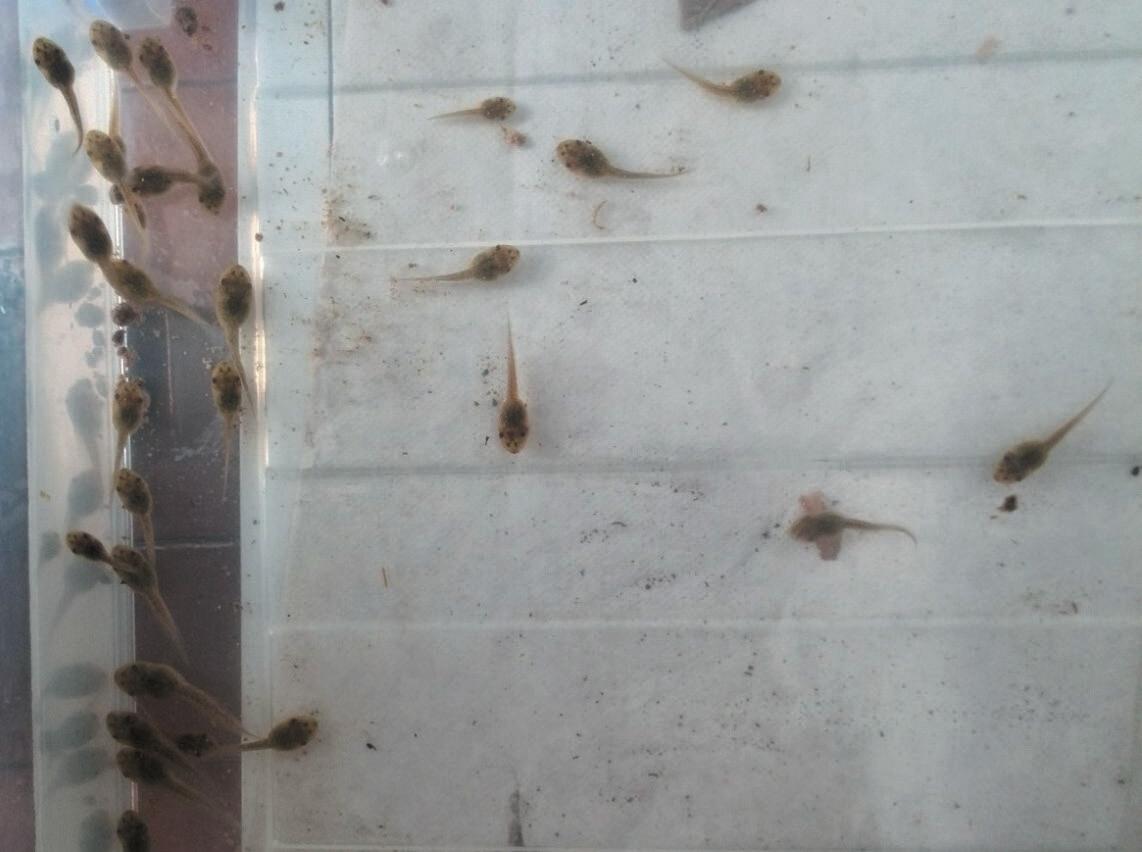

The lack of skilled labour is another deterrence for the development of this sector. While there are a lot of courses worldwide about aquaculture, frog culture has little or no
The main costs of operation are represented by labour and feed. The economic viability is based on getting cheaper food sources and performing more efficient task management to increase production with the same workforce. Before achieving the intensification of frog farming, labour cost and other management problems must be resolved.
The recent ban on bullfrog farming in Argentina due to the risk of ranavirus spread to wild populations illustrates the hazard of emerging diseases. Frog farm veterinarians have to deal with both the great variety of pathogens and the fact that little is known about amphibian pathology. Additionally, specific drugs are also out of the picture. Correct quarantine measures are the best available tool against amphibian diseases. Some of the most important diseases are the following:
• Chytridiomycosis: the so-called amphibian deadly fungus (Batrachochytrium dendrobatidis) has been involved in mass extinctions of frogs since the 1990s. Tadpoles act as carriers as they only have keratin (the targeted tissue) in their mouthparts. It mainly affects newly metamorphosed frogs disturbing skin respiration and water uptake with a fatal outcome. New frogs must be sampled for the disease and quarantine measures must be taken to protect the whole farm. Itraconazole has proven effective on chytrid fungus treatment but more trials should be done. Due to its intolerance to hot temperatures, frog farms sited in the tropics are less likely to suffer this disease.
• Ranavirus: this emerging disease of amphibians affects anurans in any stage of their life cycle. There are no external pathognomonic signs to state that ranavirus is present and therefore necropsy is advised. Quarantine and disease testing are the only effective measures against this virus. Massive deaths in the wild amphibians group are a clue to determine the presence of this virus in the area.
• Red-leg disease: it appears as hyperemia of the ventral skin of legs and abdomen caused by a systemic infection of gram-negative bacterias. It can be treated through antibiotic baths but to avoid antibiotic resistance, previous antibiogram and sensitivity tests are advised.
• Lung nematodes: they are one of the most common pathogens affecting captive frogs. Rhabdias bufonis causes loss of appetite and decreased growth rates triggering death if not treated. Captivity stress could lead to nematode infestations that must be prevented through antihelmintic treatments.
• Saprolegniasis: this is a pathogenic water mould of amphibian eggs. It appears as a superficial cotton-like growth that can affect already weakened egg clutches.
A quarantine area and a small lab are necessary to isolate diseased frogs and newcomers and perform routine procedures such as necropsies, treatment preparations and water checks.
Frogs, like other aquatic animals, depend entirely on water. In the tadpole stage, water parameters like pH, ammonia, temperature and oxygen concentration must be monitored frequently because incorrect values could be lethal. When adults, frogs must have access to water and high relative humidity with at least a daily water change to remove faeces and food debris. Common aquarium water tests should be enough to measure basic water quality parameters, but a spectrophotometer would be advisable when working with a high number of water samples.
Beyond human feeding, there are other reasons to farm frogs such as biotechnology or conservation. The so-called dart frogs (family Dendrobatidae) are a group of new world frogs characterised by producing deadly toxins. These toxins are also raw materials for promising drugs against cancer and other human diseases.
Other amphibians like toads and salamanders have their own toxins with a similar pharmaceutical interest.
For reintroduction purposes, extreme precautions must be taken to avoid the introduction of diseased individuals. Poorly managed conservation efforts could have a terrible outcome. Pet food is another sector where frog meat could occupy a relevant place due to its nutritional value.
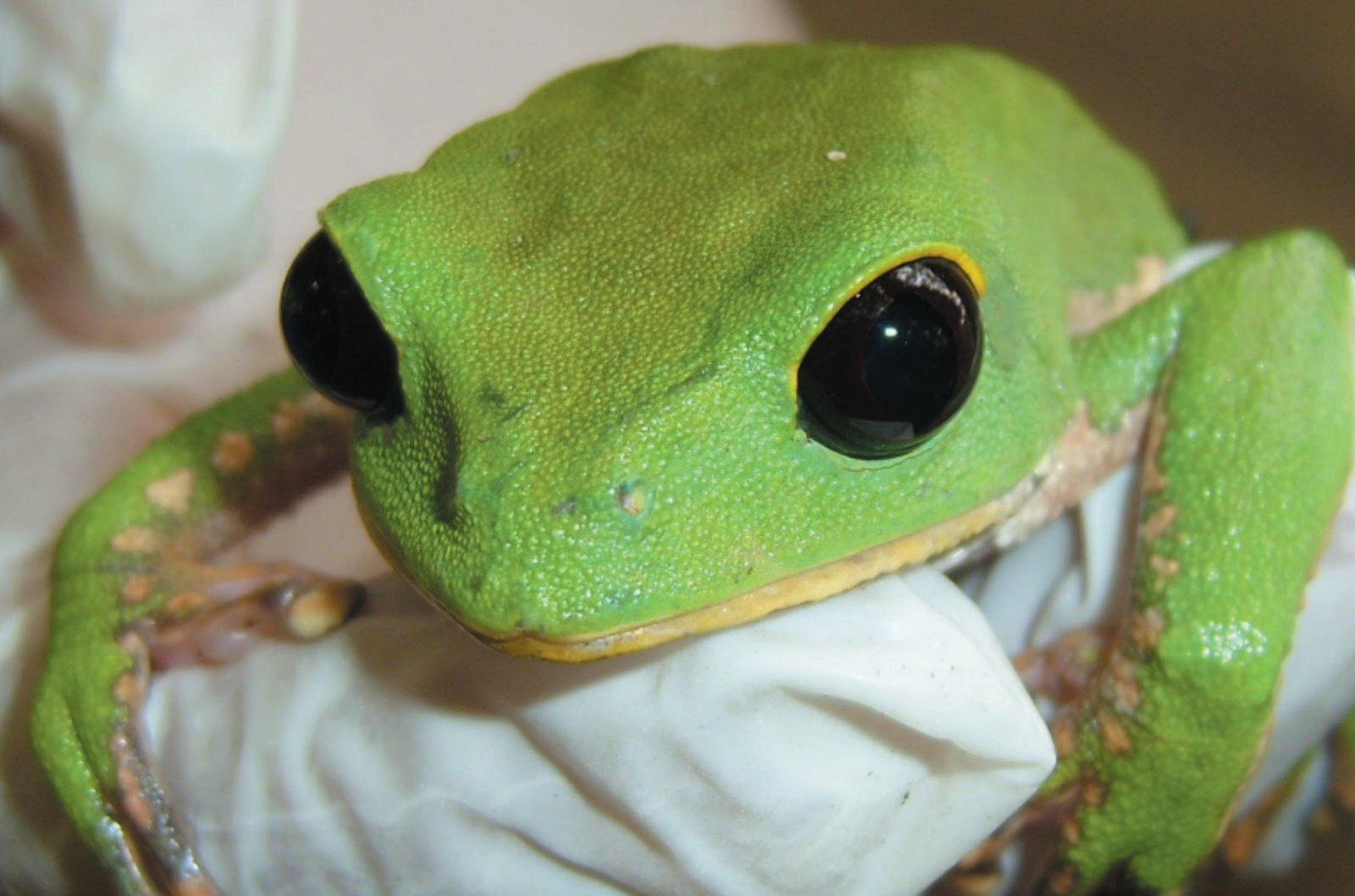
Frog farming is still an incipient and underdeveloped branch of aquaculture. The future development relies on the technification of farms, labour training and a deeper knowledge of amphibian diseases. There is a long walk ahead of professionals involved in frog farming.
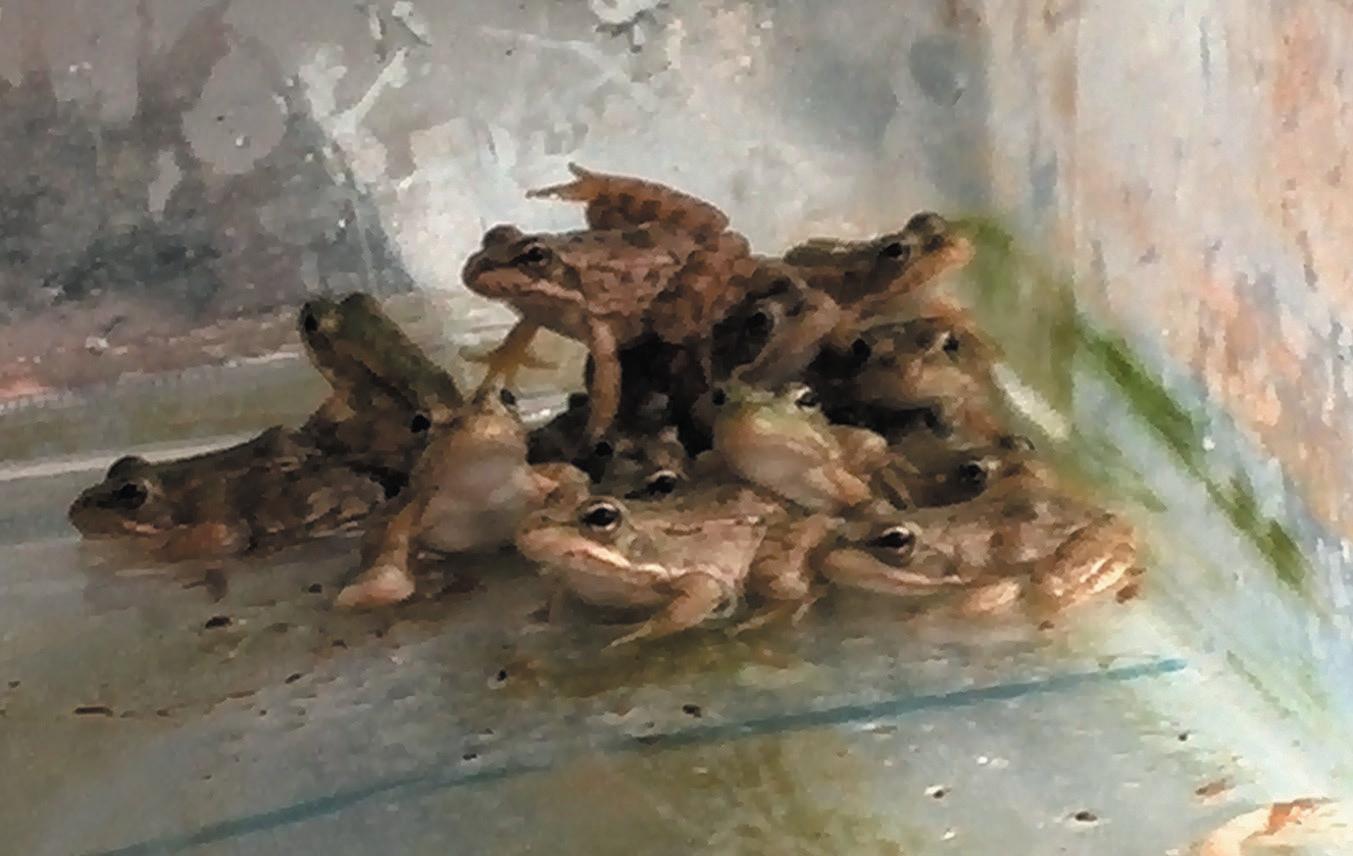
Jose Barrio is a Frog Farming technician at GrenouCerie and an Aquaculture Specialist Veterinarian. Jose is also a former public aquarium quarantine and lab manager and dart frog breeder.
Email: frogtor@gmx.com

Fabián Simón is the CEO at FEROD and the founder of Grenoucerie. Fabián Simón is also an Agricultural Engineer and frog farming R&D specialist. He has a broad knowledge of frog farming and frog leg trade.

Email: fabian@ferod.es

Cold Chain as a Service®
Integrated technology and services for your end-to-end supply chain and vaccine distribution.

Validated for all lanes—air, road, sea. Pay as you go.
Controlant is pioneering the development of next-generation visibility solutions for digitally connected global supply chains that keep products safe. Our Cold Chain as a Service® Digital Visibility Platform solution consists of reusable Internet of Things (IoT) data loggers that send mission-critical quality data and insights in real-time to a proprietary, cloud-enabled software platform, and costreducing operational services..
Businesses are leveraging the improved visibility to collaborate with stakeholders, support their corporate sustainability objectives, and achieve supply chain improvements leading to a substantial return on investment.
For more information, visit controlant.com contact@controlant.com
Follow us on Twitter @controlant
We are working for a society that cares for the wellbeing of its animals like never before. We need to. As humans, we are facing global challenges in physical, mental and environmental health.
I believe in a world where healthier animals are the key to helping us unlock today’s most critical global challenges. Healthier animals can help us solve problems like malnourishment, anxiety and resource scarcity.
You might wonder how animals are related to global issues. It sounds abstract at first, but when breaking down universal concerns, we find that at their core they are related to physical health, mental health and environmental health.
These issues affect every single one of us in some way. They cut across every aspect of our life. Let us look at some stats, so I can clarify what I mean.

First on physical health. The most basic form of physical health – the food we eat – is still a chronic, global problem. Despite abundance in some parts of the world, according to the United Nations, one in every nine people are going hungry.1 At the same time, an estimated two billion people worldwide do not have access to the right food, resulting in ‘hidden hunger’2 – a lack of important micronutrients.
Secondly, despite the wealth of communication channels we have at our fingertips, social isolation and anxiety are at an all-time high. For instance, in America, one in five millennials are lonely or say they have no friends, despite being the most internet-connected generation.3 We are more connected than ever, but we are not connecting.

And thirdly, we are more aware of climate change than ever before, but we are using resources nearly twice as fast as we can replenish them. We may not agree how, but we can all agree that we have to make a change. We must take care of the planet to safeguard the world for future generations.
Research in the US, UK and Ireland found that this is the first generation expected to live a shorter life than their parents are. That is a generation with fewer years to make a positive impact on our world.
It is a no-brainer; the world is demanding a transformation. However, this seems incredibly challenging. We lack the belief and conviction to make that change. We need a spark, an idea – and a groundswell of belief behind it.
I belief animals are the X-factor that the world has been looking for. Animals are the unexpected, game-changing variable that we believe will unlock solutions to these seemingly disconnected issues of physical, mental and environmental health.
It is a surprising idea – that cats and cows hold the key to our future.
Healthier animals can make an immediate impact. You interact with them every day. Whether it is the emotional connection we have with our dog, or the critical protein we get through milk, meat, fish and eggs, animals are central to our existence.
You may not think of it every day, but animals are part of the framework of our existence. They are worth our time and consideration. And my belief in this idea of healthy animals will require all of us making important choices when it comes to animals.
Let me further explain what I am talking about.
I already touched on some of the physical health challenges facing our world today: 13% of the global population is obese.4 More than 10% suffer from malnourishment, and one in four are getting the wrong food. We have so much information about nutrition readily available, but it has never been more confusing. How many diet trends have we had in the last decade? With several of them even classed as ‘contradictory’.
In addition, as many as two billion people who are getting enough food are suffering from shortages of essential vitamins and minerals. The crux of the obesity and malnourishment problem is the lack of availability or access to healthy food.
Over the past 40 years, in the US we have seen a decrease in calories from animal proteins like dairy, eggs and meat, as our plant-based calories have gone up. Nevertheless, in that time, we have seen obesity and diabetes increase. Surely, many factors contribute to obesity and diabetes; however, there certainly is a link between health and the intake of dairy, meat and eggs.
Let’s look at what animal protein does for our children’s diets. A protein-rich diet is essential to accelerate the height of a kid; it repairs the tissues and develops lean muscles. Let me illustrate this with some examples.
In China, as meat consumption has skyrocketed, the average height of a nine-year-old boy grew nine centimetres in the last 25 years. In Kenya, the addition of animal protein in children’s diets resulted in a 15% increase in IQ scores. And in the UK, overweight children who made subtle changes to increase protein and reduce carbohydrates in their diet saw “remarkable” impact in weight loss and health risks.
Livestock, through milk, meat and eggs, provide us with nutrient-dense foods and critical sources of protein, vital for our health. If we can increase accessibility to these animal products to those who need it most, we can help reduce incidences of disease and improve our health through more nutritious, balanced diets.
Our biggest dilemma is how we are going to cope as our population grows to an estimated 10bn by 2050.5
Right now, one in five animals are being lost to disease.6 If we can increase animal health and wellbeing, we can farm more efficiently, better conserve global resources and feed

more people the nutritious food they need. Take, for example, a disease called coccidiosis in chickens. When coccidiosis is properly controlled, the flock’s carbon footprint falls by as much as five per cent, while healthy livestock means greater access to food.
However, the impact of healthy animals on our physical health goes beyond animal protein. Let us talk about pets.
Pets enhance both our mental and physical health. The companionship they provide can help ease loneliness, providing real-life connections in an increasingly virtual world. And numerous studies have proven the physical benefits of pets. Pets encourage a healthy lifestyle. They force us to go outside, get moving, stay active.
This is especially true for older generations who often need the companionship of a dog or cat. It’s proven that for people living alone, owning a dog can improve cardiovascular health and decrease your risk of death by 33 per cent.
That human-animal bond is powerful. And it impacts our physical wellbeing in powerful ways.
Now let’s talk about mental health. More than one in three people say they experience a lot of worry or stress. At least one in five experience sadness or anger, and one in five millennials in America say they are lonely and have no friends.
Our social communities are also shrinking by as much as a third. Despite advancements in technology, communication and transportation making it easier than ever to be connected, we are more isolated than ever before.
Think about a situation in which you are waiting – for the bus for instance – how often do you talk to other people? Or do you spend your time waiting by scrolling on your phone? Do you know, if you spend more than two hours a day on social media, you are twice as likely to feel socially isolated?
Loneliness affects your health in very real ways. Research shows it is comparable to smoking fifteen cigarettes a day.7 And it’s more predictive of an early death than the effects of air pollution or physical inactivity.
So what do we do? We rediscover life beyond our devices. And healthy animals can help us do that. A pet’s ability to improve mental and social health is powerful.

Studies have shown that pet ownership is associated with higher levels of social capital – or connection to your community. Our pets help us meet people, force us to venture outside, encourage us to be playful.
Around 40 per cent of pet owners studied said they have received some type of support – such as emotional or informational – from people they met through their pet.
Outside of their ability to help us form new bonds with those around us, our pets also form meaningful bonds with us that can significantly influence our overall wellbeing.
Imagine the impact of a society that feels supported and connected. Imagine what a decrease in depression could do for our communities, our workforce, and our families. It would have a ripple effect beyond just this generation.
Finally, I would like to show you how improving the health of our animals can move us toward a more sustainable planet while addressing physical and mental health challenges.
Globally, protecting the environment is the number one cause that people care about, ahead of healthcare and poverty. We have made better strides to protect our environment – fuel-efficient cars, alternative energy, and widespread corporate sustainability practices. These innovations have had a significant impact. And we have to keep innovating.
But the reality is, we are using our resources faster than ever before. Last year, we used resources 1.75 times faster than the global ecosystem could replenish them. As we need to meet the increasing demand for milk, meat and eggs, somehow we need to use fewer resources to do so. Right now, we are experiencing more than a 20 per cent loss of animals due to disease.
The good news is that we can make an immediate impact on that amount of waste, and take a massive step to obtain more meat, milk and eggs with fewer resources. It is more than just medicines – it is working with our farmers and veterinarians, increasing knowledge, training and tools they need to help their livestock thrive – as farmers and veterinarians are dedicated to continually improving the care and wellbeing of animals.
And there’s more. Animals are the original recyclers – in fact, 86 per cent of the feed livestock eat is made of materials that humans do not or cannot consume. Cattle eat by-products, such as distillers’ grain, and convert them into healthy milk and meat.
Furthermore, about two-thirds of our agricultural land is not suitable for planting fruits and vegetables, but it is suitable for grazing animals. And, let’s not forget that livestock animals provide nutrient-rich manure as fertiliser to the food production process, representing recycling in its purest form.
I would like to add a clear example of why talking about healthy animals is so imperative. As much as 50% of China’s hogs have been lost to African Swine Fever, creating a huge impact on China’s pork market. The impact is so severe that there is no combination of imports or production of other animal protein that can fill the gap. This will directly affect the ability of the world’s largest population to access animal protein, and it will influence global health and environmental outcomes.
It is time to strengthen and improve our world’s resources by improving animal health.
It is simple. But it’s powerful. And it’s right in front of us. If our pets live longer, healthier lives – so will we. It is time to rediscover how animals give us happier, more connected people and communities.
Healthy animals are not a “nice-to-have” for our world. They are a must-have.
This concept that animals are the X-Factor – it is not a marketing tool for us. It is the realisation of decades of dedicating our work to the health and wellbeing of animals. We know first-hand how powerful, and how critical animals are to our world.
And we can make a difference. By eliminating a pest, by reducing animal losses, by using less feed to generate more servings, and most of all by helping animals live healthier lives.
1. The State of Food Security and Nutrition in the World 2018: https://www.who.int/news-room/detail/11-09-2018global-hunger-continues-to-rise---new-un-report-says (accessed September 2019)
2. World Health Organization, Preventing and controlling micronutrient deficiencies in populations affected by an emergency: https://www.who.int/nutrition/publications/ WHO_WFP_UNICEFstatement.pdf (accessed October 2019)
3. https://today.yougov.com/topics/lifestyle/articlesreports/2019/07/30/loneliness-friendship-new-friendspoll-survey

4. https://www.who.int/news-room/fact-sheets/detail/ obesity-and-overweight
5. United Nations, News: https://www.un.org/development/ desa/en/news/population/world-population-prospects2017.html (accessed September 2019)
6. HealthforAnimals, Global Challenges: https://healthforanimals.org/animal-disease.htm (accessed September 2019)
7. Julianne Holt-Lunstad, Timothy B. Smith, Mark Baker and all, Loneliness and Social Isolation as Risk Factors for mortality: A Meta-Analytic Review, March 11, 2015
Dr. Ramiro Cabral serves as executive vice president at Elanco Animal Health International. In this role, he leads Elanco’s international commercial operations. He was most recently responsible for Elanco’s business in Europe, the Middle East and Africa. Previously, he served as Area Director for Western Europe. Cabral brings a lifetime of global experience across diverse portfolios of animal health to his position. In over twenty years with Elanco, he has been a valuable member of the Elanco team, serving in roles including technical sales at Elanco Argentina, global marketing manager, beef business unit director in the U.S. affiliate and affiliate director at Elanco Canada. Prior to joining Elanco, he worked on his family’s farm and served as a consultant in the veterinary and agribusiness industries. Cabral earned a Doctorate of Veterinary Medicine degree at UNICEN, Argentina in 1995 and a Master of Business Administration from Purdue University in 2005.

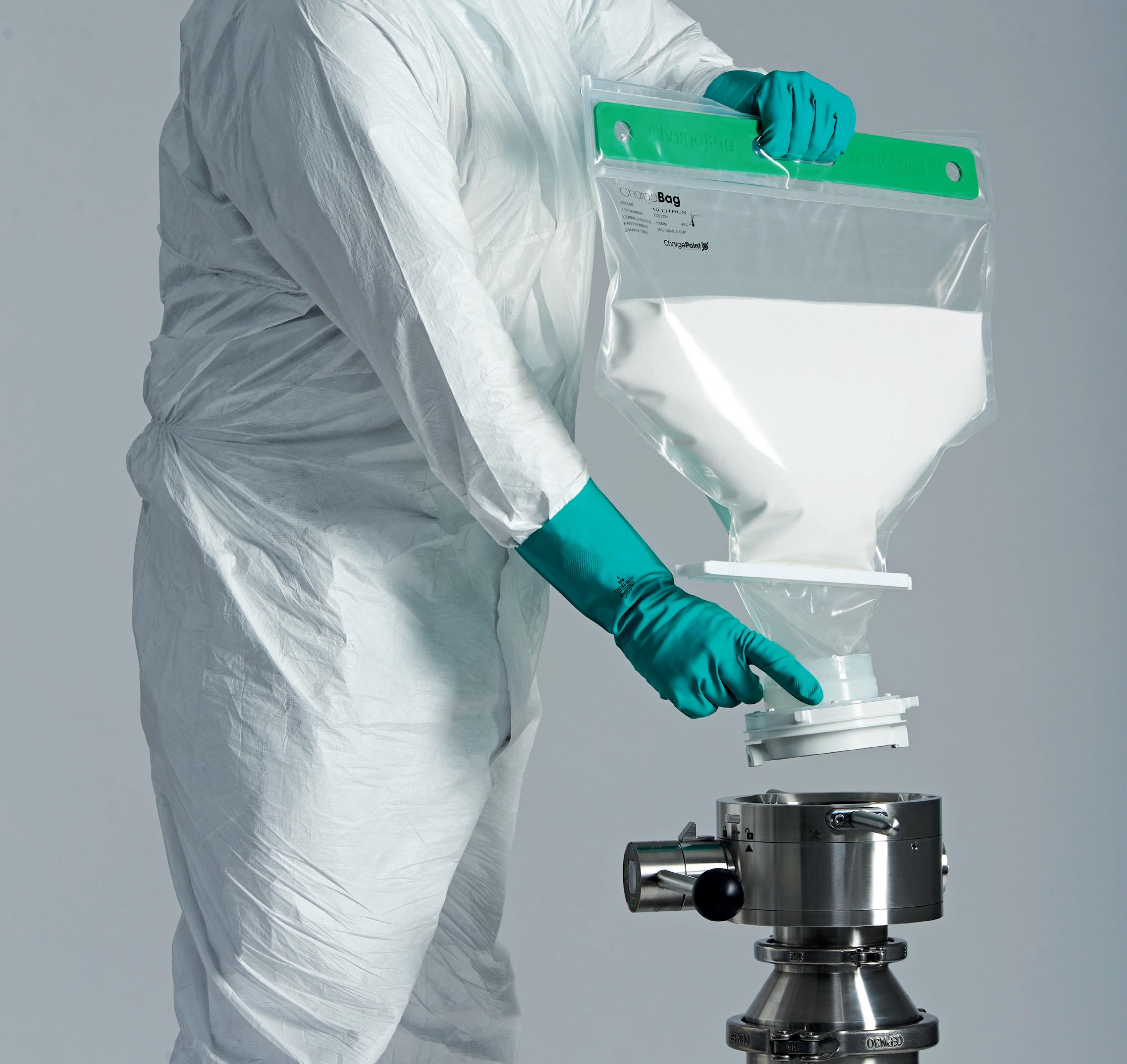
Quarantine is a key issue when dealing with ornamental fish. The rapid spread of pathogens through the water alongside a less advanced immune system (compared to mammals) makes a correct "biosecurity plan" mandatory.
Icthyopathology, the study of fish diseases, is a growing area with a wide range of job opportunities, but is often disregarded by veterinarians. In fish, most pathologies appear due to poor management of water quality, lack of quarantine and preventive treatments, poor nutrition and incompatibility between tankmates. Knowledge of fish diseases comes mostly from aquaculture and the number of drugs with proven efficacy is very small, with even fewer drugs authorised for use in fish. The great diversity of ornamental fish species makes the work even harder. We could say that a surgeonfish and a shark are as similar as a cow and a dog (differences in diet, the anatomy of the digestive system,...). The key to a healthy aquarium includes adequate water quality, proper nutrition and preventive healthcare.
The mortality pattern is key information when working with fish. It can help us discern whether it is an infectious disease, water intoxication or pathology affecting only one or a few individuals. Mass mortality appears when a toxic product poisons water, most commonly ammonia and nitrates. Daily mortality of several fish in a period of time (“drip mortality”) happens when an infectious agent is present. In that case, we must consider the tank as a "diseased aquarium". Mortality of a few individuals could be the consequence of aggression by tankmates or husbandry-related problems.
Drug administration in small fish, shoals and “diseased aquariums” is frequently done through bath treatments. This can be performed in two ways: long-term bath or short-term bath. The first one involves dissolving the drug in the aquarium according to the dose and periodicity indicated. We must ensure water quality, temperature and oxygenation while the aquarium is under treatment. The latter consists of dissolving the drug in a container with water from the aquarium, with the fish returning to the tank after the treatment. An air diffuser must be fitted to maintain the oxygen level in the container in order to avoid oxygen depletion.
Biosecurity involves the measures taken to avoid the spread of infectious diseases. The first step is the risk evaluation according to the source of fish.
Fish arriving from another aquarium or zoo are theoretically the ones with the lowest risk. We must request information about preventive healthcare measures, previous diseases and treatments, and infectious diseases detected in the Centre. Aquarium fish wholesalers must be certified importers, due to the large volume of fish from different species and sources they handle. Thus an exhaustive quarantine must be carried out. Fish coming from an aquarium shop or home aquarium (often the ones that have grown too large for the aquarium) pose a greater risk. There is little chance that home aquarium fishes have been quarantined and even at the shop, quarantine is not always done due to the high
turnover of fish. Regardless of the origin, it is essential to know the parameters of the water in which they live and the type of diet to ensure proper adaptation.
Wild-caught fish must be handled – as they carry infectious pathogens – by taking the highest biosecurity measures. This involves a longer quarantine with stronger antiparasitic drugs and preventive treatments prior to transfer to the exhibition tanks. They can be carriers of parasites with indirect life cycles, uncommon in captivity due to the absence of their intermediate hosts.
A quarantine facility must act as the first barrier against infectious diseases. The entry of new fish is the greatest threat to the biosecurity of the aquarium. They must arrive directly at the quarantine facilities and be housed in isolation from other specimens. The quarantine facility should be divided into three isolated areas: the first one for newly arrived fish, another one to treat sick fish from exhibition tanks and a third for the breeding stock. Whenever possible, fish should be accompanied by their corresponding health certificates such as in the case of imports from an area with endemic diseases. Staff and visitors can also act as vectors, introducing pathogens through their shoes from the exhibition area or from outside. The presence of a footbath containing a sanitizing product is the first wall against pathogens. The water source must be suitable in terms of chemical and microbiological parameters and a preventive pest control programme is mandatory as they can be vectors of disease. Live food must be monitored, especially those species that can act as intermediate hosts for fish parasites.
We must also take into account the risk of pathogens leaving the quarantine area. Effluent water, organic wastes and corpses must be adequately managed. Waste water coming out of the quarantine tanks must be treated to prevent the leakage of fish eggs and larvae, parasites, and other pathogens. Any fish that leaves the facility will pose a serious threat to wild fish and amphibian populations by predation or introduction of infectious diseases.

We cannot determine the exact length of quarantine. It will depend, among other things, on the risk assessment carried out upon the arrival of the animals. The quarantine must be as long as necessary to ensure that the specimen arrives at the exhibition aquarium in perfect health condition and fully adapted to the feeding and maintenance conditions (especially in wild-caught fish). As a general rule, a minimum of thirty days for fish and no less than a fortnight for aquatic invertebrates is recommended. Coldwater species require an extended quarantine as they take longer to show symptoms of the disease. The quarantine will be over when the preventive treatments are completed, and the fish are fully adapted, showing no sign of disease.
Some pathogens, such as the protozoan parasite responsible for the white spot disease (Ichthyophthirius multifiliis), can remain as saprophytes inside the body or free in the environment. When the fish is stressed (sudden temperature drop, poor water quality, and so on) these pathogens proliferate and cause disease. Other pathogens
thermoregulation. Therefore, the water temperature must be maintained within the optimal range of the species. It also influences the metabolic rate and oxygen consumption.
pH is a coefficient that expresses the hydrogen ion concentration of the water, the degree of acidity or basicity. The usual pH for aquarium fish ranges between 6.5 and 8.5, varying with different species. Alkalinity measures bicarbonate and carbonate ion concentration, indicating the capability of water to neutralise acids. This buffer capacity prevents sudden fluctuations of the pH of the water, thereupon pH and alkalinity are linked.
will enter with the new specimens (crustaceans such as Argulus sp. or Lernaea sp., Koi carp virus, ...) instead. The stress induced by transport, acclimatisation and adaptation to the new environment will exacerbate pathogens carried by the specimens. The major goal is to detect, diagnose and treat these diseases during the quarantine period to prevent the development of disease on display tanks. This is achieved by monitoring new specimens and performing preventive antiparasitic treatments.
Another mission of the quarantine facility is to accommodate and treat sick individuals from exhibition tanks. The isolation reduces the stress and allows the modification of water parameters according to the needs of the treatment (e.g. raising the temperature). Additionally, the smaller size of quarantine tanks eases fish handling and inspection.
Reproduction of key species is also a function of this area in a public aquarium. We refer to species with high value, such as those that are extinct or in danger of extinction, subjected to captive breeding programmes. Controlled breeding enables greater control over environmental parameters that trigger reproduction and the development of exhaustive breeding protocols.
Aquariums should carry out research, to the extent possible, to improve knowledge on different areas, including nutrition, pathology and ethology. In addition to improving the wellbeing of captive animals, those investigations have a great impact on the conservation of wild counterparts.
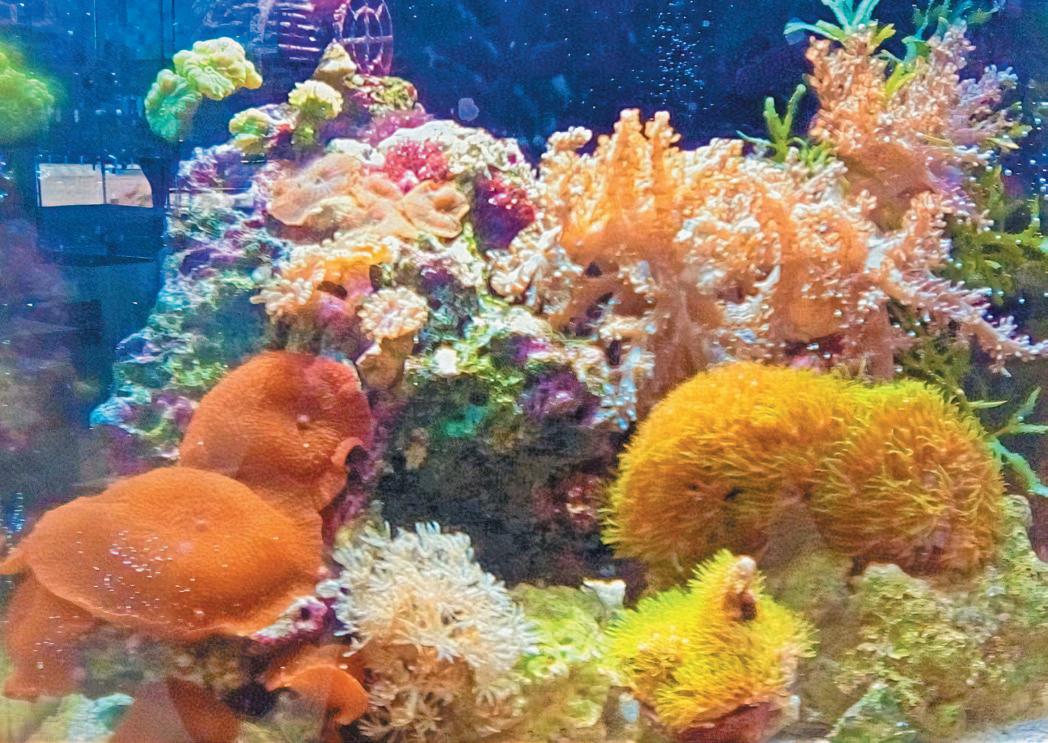
Water quality is the most determining factor in fish welfare, therefore water testing is one of the best tools to determine the current state of an aquarium. Deviation of the parameters from the optimal range (species-specific), as well as sudden changes, will be decisive in the occurrence of pathologies. Working as an ornamental fish veterinarian requires knowledge not only on fish diseases but also on water chemistry.
Oxygen is essential for life, and temperature-dependent. At higher temperatures, the oxygen concentration is lower, as it is at the same temperature in saltwater compared to freshwater. Movement of the water surface helps increase the availability of oxygen. Aquatic plants are also part of this, producing oxygen during the day and consuming it at night (photosynthesis). Values of less than 3 ppm (mg / l) of oxygen could be dangerous with the ideal concentration above 5 ppm (mg / l). The great majority of fish are poikilotherms, namely, they are dependent on water temperature for
Most of the fish excrete nitrogenous compounds through their gills as ammonia, highly toxic for fish and other aquarium inhabitants. It also comes from the decomposition of organic matter (food remains, dead fish, …). There are a few genera of bacteria involved in the conversion of ammonia in less toxic compounds through the process known as the “nitrogen cycle”. Firstly, Nitrosomonas spp oxidises the ammonia, turning it into nitrite, which is a still-toxic product. Then, Nitrobacter spp. and Nitrospira spp. convert nitrites into nitrates, the outcome of the oxidation of nitrogen compounds. Even if most fish are tolerant to nitrates exposure to high levels, it should still be avoided. Ideally, it should not exceed 5-10 mg/l (ppm). Weekly partial water changes are mandatory to maintain adequate nitrate levels, with plants doing their part for nitrate consumption.

The rapid transmission of pathogens through water makes it necessary for the treatment to be established as soon as possible. We cannot wait for the test results; fish must be treated according to the presumptive diagnosis. Once the results have arrived, we will maintain or modify the previously chosen treatment. Many bacterial pathologies show the same symptoms, such as exophthalmia, abdominal swelling and skin bleeding.
Some of the most common diseases ornamental fish face are the following:
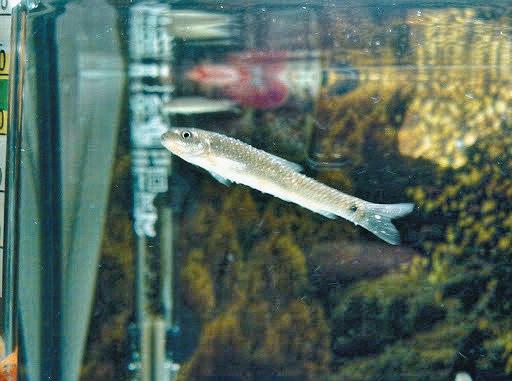
Fin rot: caused by various gram-negative bacteria. One of the most common pathologies in aquarium fish (along with the white spot disease), often in aquariums with poor water quality. It manifests with eroded fins (frayed and whitish on the edges) that can be treated with commercially available disinfectants.
Pseudomoniasis: Pseudomonas spp. Unspecified symptoms such as exophthalmia, abdominal swelling and raised scales. Necropsy findings include accumulation of serous fluid in the
celomic cavity (ascites). Treatment consists of antibiotics and elimination of stress factors (incorrect water parameters, excessive biomass, ...).
Saprolegniasis: Saprolegnia spp. This fungus is naturally present in freshwater and only colonises dead tissue, manifesting as whitish cottony growths. It is an opportunistic pathogen that can also infect egg clutches. When detected in the initial phase it is readily removed through long-term antifungal baths.
Lymphocystis: Lymphocystivirus. Highly contagious incurable disease favoured by low temperatures and poor water quality. These cauliflower-like tumours grow both internally and externally, causing anorexia and death when appearing in the mouth. Fish isolation and euthanasia are the only viable measures.
White spot disease (Ich): the most common disease in aquarium fish, caused by ciliated protozoans: Ichthyophthirius multifiliis in freshwater fish and its saltwater counterpart, Cryptocaryon irritans. Scratching against objects is the first symptom with the rapid development of white spots (trophonts) on skin, fins and gills. The trophonts detach from the fish and adhere to the substrate, forming the tomonts (cysts) that release tomites, the infective phase. Temperature
rise (28–30ºC, caution should be taken with coldwater fish) is advised to speed up the life cycle of the parasite to the adult phase. In this stage, ich can be treated with long-term disinfectant baths.


Rising global interest in public aquariums is helping to further knowledge on ornamental fish diseases and husbandry. The great diversity of species kept in their tanks and the multidisciplinary approach favours data collection on different areas such as nutrition, behaviour and pathology. New discoveries are still to come in the near future with the effort of aquarium-related professionals.
Jose Barrio is an aquaculture specialist veterinarian and former public aquarium quarantine and laboratory manager. He is currently a teacher on aquariology and aquarium management related courses and a frog farming technician.









Corrosion can severely affect tablet compression tooling used in the production of animal medicine if it is not addressed effectively. It can delay production, reduce efficiency, and cause contamination problems. There are several reasons why corrosion can occur, and although challenging, it can be resolved with a combination of the correct tool steel selection, coating or treatment and maintenance procedures.
Corrosion can be detected by the appearance of discolouration, etching or common red rust. The main cause of corrosion are acidic substances that can include ingredients found within the formulation being compressed, and even in the surrounding atmosphere. The iron particles in the metal tooling are exposed to oxygen and moisture in the form of humidity or vapour. When the steel is exposed to water, the iron particles are lost to the water’s acidic electrolytes. This means they oxidise the iron particles which forms corrosion on the punches and dies.
One of the principal causes of corrosion is excessive moisture and humidity. This is because corrosion often forms in areas where liquid is present. Oxygen is found in the air we breathe and humid air carries water. The percentage of water vapor in the air varies based on temperature and can range from as low as 0.2 percent to up to 4 percent water vapour1. Excess humidity in the compression room, tool storage area, or places where the formulation is stored prior to compaction can have a significant impact on corrosion forming on the tooling. It is therefore extremely important to control the environment in all areas of tablet production.
As we cannot remove oxygen from the air and tooling is made from steel, considerations should be in place if required to regulate the temperature and humidity, minimise moisture, and ultimately to prevent corrosion from forming on the punches and dies.

All formulations have very different characteristics with varying moisture content, which is often needed to help bind the tablet structure. However, too much water within the tablet can be a cause of corrosion and lead to other problems like sticking with a rise in adhesive forces.
It is not just moisture content within the formulation that can lead to corrosion. Formulations containing corrosive elements such as chlorine, salts and acids will react with the tooling surfaces and result in oxidation.
Optimising the tablet compression and tooling storage environments can have a significant impact on preventing corrosion, but other solutions should also be considered.
Granulates can contain corrosive elements which react with the steel. This reaction can lead to tabletting defects like black spots which are the result of corroded tooling and sticking
where the granulation adheres to the punch tip face causing costly wastage, reduced yield and unwanted press downtime.
Furthermore, corrosion could also be caused by abrasion. Some products contain hard and abrasive granules that can scratch, wear, and impregnate the steel surface. This rougher surface forms pockets on punch tip face where moisture can be trapped or retained. Due to the coarse nature of the formulation being compressed, particularly in animal health where dosages are high and granules may be larger, wear is a common problem. The repetitive cyclic action of compression will take its toll on tooling, particularly if they are not maintained.
Although tools are manufactured from hardened and tempered tool steel, the demanding processes involved can lead to deterioration if the tool material is not optimised to suit the formulation being compressed.
High quality tooling should be able to offer a long life, provide anti-stick properties, be anti-abrasive and corrosion resistant. The appropriate choice of material will help to reduce the risk of damage to the punches and dies from the effects of abrasion and corrosion.
The correct steel is crucial to the successful performance of tablet compression tooling. There are several characteristics that should be addressed when selecting steel:
• Strength: Ability to withstand an applied stress without failure.
• Corrosion resistance: Resistance to oxidising, staining and discolouration.
• Toughness: Resistance to chipping, cracking and punch tip breakage.
• Abrasive wear resistance: Resistance to abrasive wear of punch tips and die bores.
• Adhesive wear resistance: Resistance to adhesive wear, galling and welding.
• Hardness: Resistance to impregnation from hard, sharp granules.
• Compressive strength: Resistance to die bore ringing and plastic deformation of punch tip edges.
• Fatigue resistance: Progressive and localised structural damage that occurs when a material is subject to cyclic loading.
If the tooling being used is prone to corrosion due to environmental effects or because of the characteristics of the formulation, a specially selected tool steel is a good option. Specialised martensitic stainless steels with high chromium content should be used as they have a higher resistance to oxidisation, staining and discolouration of the tablet tooling.
The correct tool steel choice is essential in the prevention of corrosion, but so too is the tool coating and treatments.
Tool coating selection can have a fundamental impact on production. When used in conjunction with high quality tooling steel, tool coatings are a great method of solving tablet production problems. They allow for better tabletting efficiency and output by reducing the requirement for tools to be taken
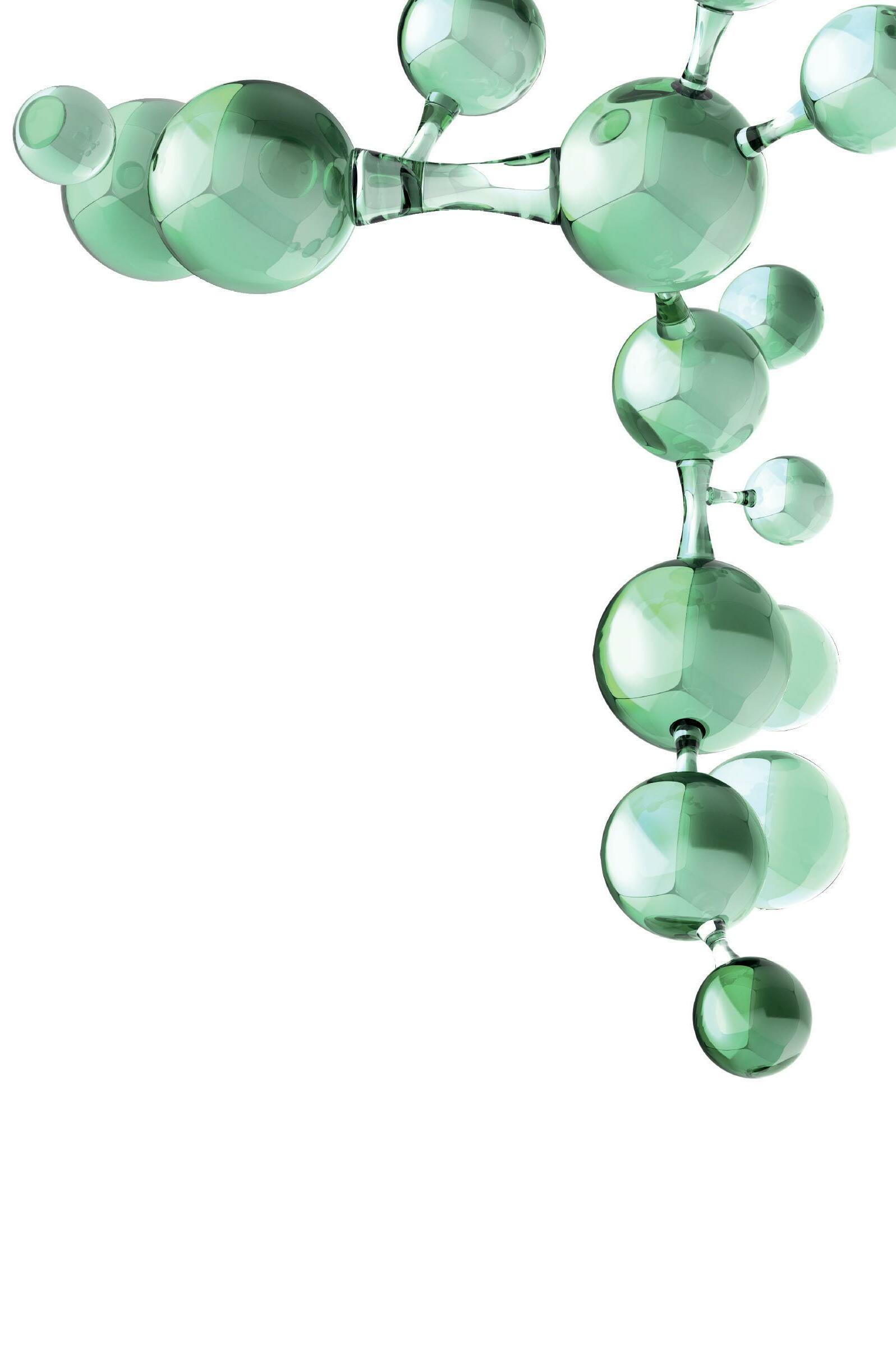

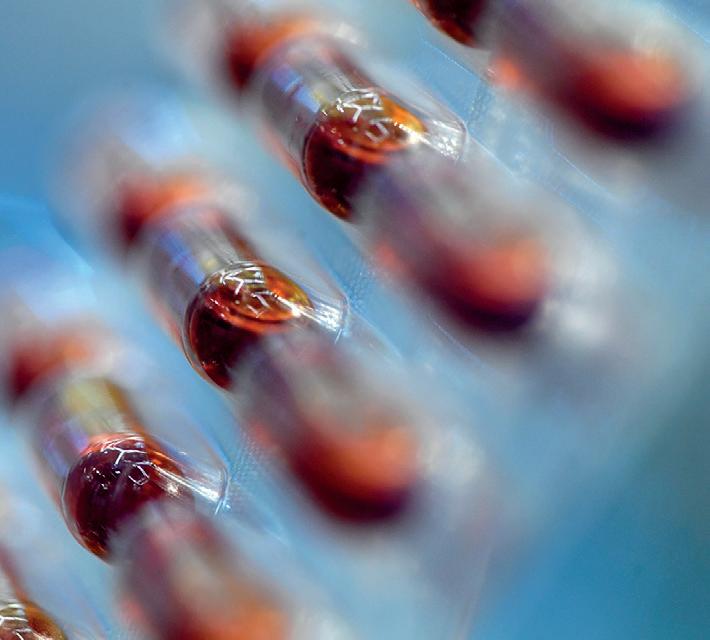


out of production for additional cleaning and maintenance work to remove problematic residue, which, if left untreated, may cause potential production issues, such as corrosion, sticking and picking.
Traditionally, electro-plated hard chromium was the most popular coating used within the tablet tooling industry, but it has many disadvantages. When hard chromium is applied to tooling, a certain amount of hydrogen penetrates the substrate, which can decrease the steel’s working load by up to 20%. To counter this effect, the plated tools undergo a baking process known as de-embrittlement that reduces but does not eliminate the unwanted characteristic. It is also subject to micro-cracks which can develop during the plating process when the internal stress exceeds the tensile strength of the chromium. These micro-cracks are problematic because they provide a porous route to the substrate that will allow granule or cleaning solutions to attack the steel beneath.

Specialised coatings have been developed which are chromium-rich and applied via an advanced Physical Vapour Deposition (PVD) process. The PVD process creates a very

When it comes to choosing a tool coating, understanding the product being compressed is crucial. For example, if the formulation has a high number of corrosive elements like salts and acids, it will eventually react with the steel and result in oxidation and other forms of decay. In these instances, an appropriate corrosion resistant coating should be selected, for example, those containing chromium or chromium nitride.
Incorrect tool maintenance procedures including the handling, cleaning, polishing and storage of punches and dies can have a huge impact on tablet production. All of these processes will expose the tooling to materials and environments where there is a risk of oxidisation. It is therefore important that tried and tested maintenance practices are in place to prolong tool life.
The purpose of regular tablet tooling maintenance is simple: to minimise compression problems and ensure that it operates at its highest functionality. Ensuring tablet punches and dies
are kept in optimum condition to produce high quality tablets is critical for productivity and overall equipment effectiveness (OEE). Frequent audits of procedures should be planned to maintain and protect against corrosion issues. The cost of poor tool care and maintenance not only results in additional unnecessary tool purchases but also in production problems that could have been avoided.
The appropriate cleaning procedures are essential when looking to prevent corrosion. For example, wash in place systems fitted to some modern tablet presses expose tooling to water and cleaning solutions. Post-compression cleaning procedures can also cause corrosion if not controlled appropriately. It is therefore important that tooling used to manufacture veterinary medicinal products (VMP) and animal nutraceuticals have the appropriate corrosion resistant properties through the correct steel and coating selection.
Correct cleaning procedures will remove granule from the punch and help to avoid product contamination and potential production issues such as sticking, and picking caused by old product adhering to the surface of the punch tip.
When tooling is removed from the tablet press, it must be thoroughly cleaned to remove any oil or product residue, particularly from difficult to reach areas such as embossing and keyways. One of the most reliable cleaning methods is ultrasonic cleaning. Ultrasonic baths allow for consistent cleaning results, reduced processing and operator time, and reduced risk of tablet contamination. Importantly, ultrasonic cleaning allows for the whole punch to be cleaned including in and around the embossing. It is essential, however, that the process does not cause corrosion of the tooling material, therefore a corrosion inhibitor should be added to the cleaning cycle at a defined concentration. This will form an oxide film on
the surface of the metal, passivating the steel and protecting it from corrosion.
It is also important to remember to thoroughly dry tooling after cleaning to ensure there is no residue of cleaning fluids left on the tooling surface which could cause corrosion.
After cleaning is also the ideal time to accurately assess the condition of the tooling. If punches are not clean, any visual assessment of the punch tips and die bores can be affected. This would mean that problems like wear, damage or corrosion are missed. Appropriate storage and lubrication are other critical processes to consider when preventing corrosion. Tooling can be exposed to moisture if the storage system is not clean and dry. A good storage facility with tooling protected by a layer of non-toxic, FDA compliant oil or grease will help prevent corrosion from forming on the tooling surface. The duration of the tooling storage will determine if oil (short term) or grease (long term) is required.
Handling of the tooling can be another cause for concern. It is always recommended to use gloves when picking up tooling. This is because acids and moisture are present in human hands and can cause and accelerate corrosion on tooling. It is not unheard of for a rusty fingerprint to be left behind! Ensuring gloves are worn at all times and following proper maintenance procedures and techniques will prevent this from happening.
Adopting a simple structured tooling maintenance process is essential to obtain the maximum life from punches and dies. By applying these recommended ‘best practices’ problems like corrosion will be prevented and tool life will be extended.
The cost of corrosion due to not understanding the characteristics of the formulation and poor tool care and storage not only results in additional unnecessary tool purchases but also in production problems that could have been avoided. It is important to address corrosion at the root cause so tablet production is not affected.
Know the granule being compressed, does it contain hard and abrasive granule or ingredients that contain chlorine, salts and acids? Is there high moisture content in the air where compression and storage take place? If the answer is yes, it is important to protect tooling so corrosion does not take hold.

Through the use of the correct tool steel and corrosionresistant coatings, durability and efficiency of tablet tooling will increase. Add to this effective maintenance and tool care procedures and VMP and animal healthcare manufacturers can obtain the maximum life from tablet punches and dies.

Liam Preston is a Technical Sales Manager currently supporting customers with all of their tooling needs. He joined I Holland in 2015 as a Sales and Service Engineer, providing on site technical support for our PharmaCare products around the globe. Liam has been key in the testing and implementation of the I Holland Tool Management System and has travelled the world supporting customers with all of their tooling technical queries, training and PharmaCare installations.

Feed can account for up to 70% of operating costs for poultry producers. Unfortunately, issues with climate change, international conflict and supply chain challenges are only adding to this. This has left many producers looking for alternative and innovative solutions that will not only help lessen this financial burden but also help improve animal performance.

Although poultry are quite efficient at converting feed to protein – especially compared to some other livestock species – a significant portion of energy and nutrients in the feed is never fully digested and gets excreted into manure. This is partially due to the feed matrix and the bird’s ability to fully digest grains, seeds, meals and other feedstuffs. Plant-based ingredients are commonly used in poultry feeds, but energy and nutrient availability vary depending on the source. Energy can be one of the most expensive inputs in poultry diets, so maximising its use in poultry feed improves efficiency and has the potential to lower feed costs.
Plants store energy-providing nutrients (like carbohydrates) as simple sugars, starch and non-starch polysaccharides (NSPs). While simple sugars and starch are readily digested by poultry, NSPs are not because poultry do not produce the adequate digestive enzymes required to break down these complex molecular formations into absorbable carbohydrates.
NSPs can be categorised as insoluble or soluble, each impacts nutrient digestibility differently. Insoluble NSPs occupy space in the digestive tract that can create a physical barrier against digestive enzymes and nutrients. Soluble NSPs increase the viscosity of digestive tract contents, disrupting
the digestibility and absorption of proteins, lipids and other carbohydrates. The NSP content in poultry feed ingredients ranges from approximately 10 to 30%, with higher amounts of NSPs typically found in cheaper, non-conventional feedstuffs and agricultural waste by products.
Phosphorus is an important nutrient for growth and production. It is abundantly present in a wide variety of plantbased feedstuffs, but phytic acid, which is the storage form of phosphorus in plants, is not easily digested by poultry. Because of this, phosphorus is often supplemented in poultry diets as an inorganic mineral salt. However, phytic acid can negatively interact with amino acids and minerals, reducing nutrient digestibility and rendering minerals unavailable for absorption. Additionally, supplementing inorganic phosphorus in poultry diets to address poor feedstuff utilisation contributes to the phosphorus pollution of soil and water, largely due to the excessive amounts excreted into poultry manure that is then used as crop fertilizer.
Digestive enzymes are produced throughout the avian digestive tract and help initiate vital chemical reactions to process feed into usable energy and nutrients. Unfortunately, there are certain enzymes that poultry either lack entirely or do not produce in sufficient quantities, essentially leaving antinutrients like NSPs and phytic acid molecules unchecked. This can be remedied by adding exogenous enzymes to poultry diets. Carbohydrase and phytase enzymes – which turn carbohydrates into simple sugars and increase the digestibility of phytate phosphorus – are key to degrading NSPs and phytic acid and unlocking energy and nutrients from feedstuffs. This allows poultry to use energy and nutrients in feed ingredients better. When adding feed enzymes to a diet, looking at the overall poultry diet is crucial instead of focusing on single ingredients. Considering the

range and blend of ingredients used in poultry diets, the use of multi-enzyme complexes can be advantageous to poultry producers.
Recent studies have shown the efficacy of exogenous enzymes in improving nutrient usage. Broiler and layer research trials conducted at the University of Kentucky (USA) and presented at Poultry Science Association annual meetings have demonstrated the benefits of including Allzyme Spectrum® in nutrient-reduced diets. Allzyme Spectrum is a multi-enzyme complex that maximizes nutrient utilization by breaking down the problematic substrates typically found in a poultry diet, such as NSPs and phytic acid.
The 42-day performance of commercial broiler chicks was evaluated after feeding the following corn-soybean mealbased diets:
1. Positive control (commercial-level energy and nutrients)
2. Nutrient reduced (-90 kcal/kg ME, -0.15% available phosphorus (aP), -0.15% calcium (Ca) vs. diet 1)
3. Diet 2 + 200 grams per ton of Allzyme Spectrum
Observations (Figure 1):
• Broilers fed the nutrient-reduced diet without enzyme supplementation had the lowest weight gain, feed intake and poorest feed conversion ratio (FCR).
• Broilers fed the nutrient-reduced diet with Allzyme Spectrum had the same weight gain, feed intake and FCR as positive control birds that were provided commerciallevel energy and nutrients.
The 44-week production performance of brown layers was evaluated after feeding the following corn-soybean mealbased diets:
1. Positive control (commercial-level energy and nutrients)

2. Reduced Ca and aP (vs. diet 1 by 0.15%) + 250 FTU/g commercial phytase
3. Reduced Ca and aP (vs. diet 1 by 0.15%) + 200 grams per ton Allzyme Spectrum
4. Reduced nutrient (vs. diet 1 by 90 kcal/kg ME, 0.15% Ca, 0.15% and aP) + 200 grams per ton Allzyme Spectrum
Observations:
• When enzymes were provided in layer diets, there were no differences in feed intake, hen day production or feed conversion, despite reduced nutrient inputs compared to the positive control (Table 1).
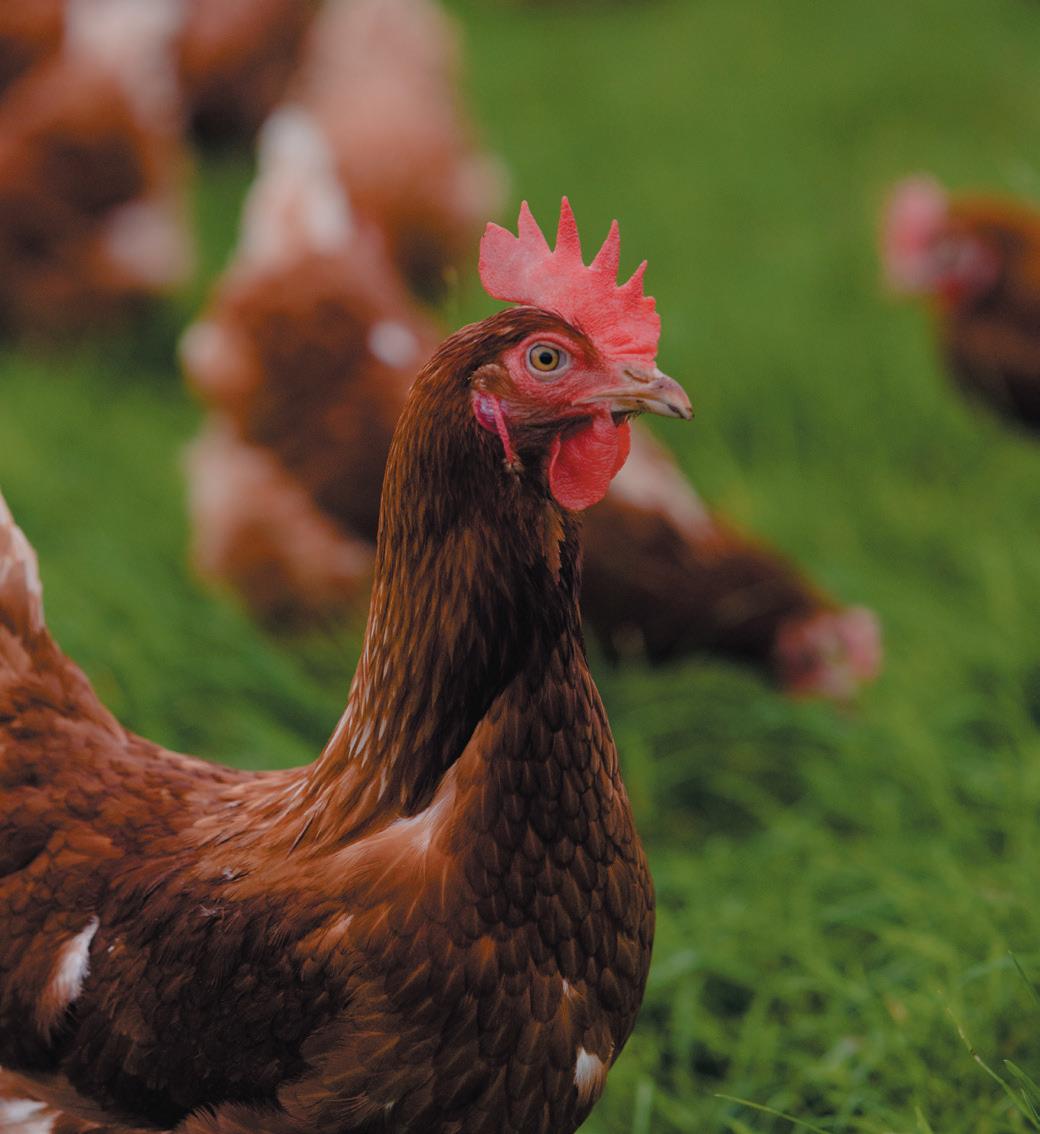

• Layers fed a commercial diet or diets containing reduced levels of nutrients with enzymes did not produce eggs of different weights, eggshell-breaking strength and eggshell percentage (Table 2).
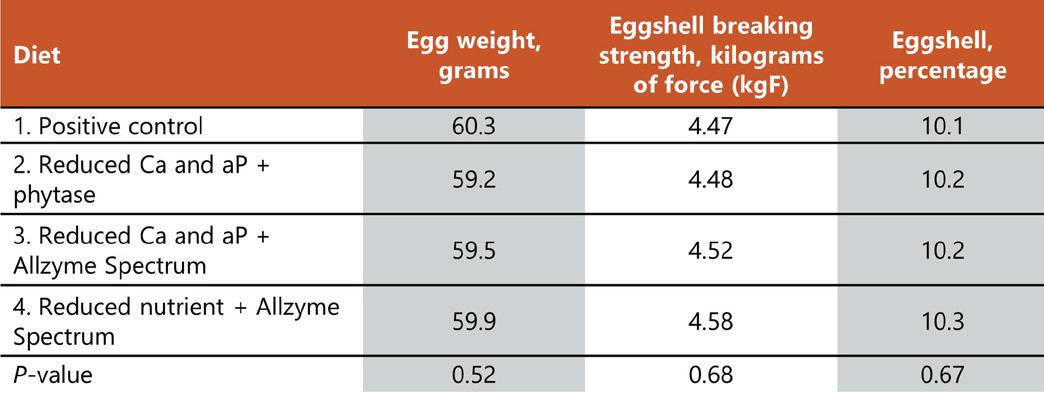
When the supply and price of conventional feedstuffs such as corn, wheat and soybean meal is a challenge, less conventional, lower quality feedstuffs and waste by products become more attractive to producers because they provide some nutritional value. Enzyme supplementation can help animals digest, absorb and utilise energy and nutrients from those less conventional feed ingredients, leading to improved performance and reduced environmental nutrient excretion. Over time, those benefits can significantly impact the producer’s bottom line and sustainability efforts.
Sustainable farming practices will continue to play a vital role in helping the agrifood community keep up with the dietary demands of our growing population. Innovative nutritional solutions – including multi-enzyme technologies like Allzyme Spectrum – can help improve the productivity and profitability of animal production while also providing significant sustainability benefits.
Marquisha Paul is a research scientist at Alltech. She earned her master’s degree and Ph.D. in animal and food science from the University of Kentucky. She has over 15 years of experience in applied poultry nutrition research with broiler, layer and breeder models.
Table 1: Brown layer performance through 44 weeks of egg production

The circular economy, or circularity of a system, is an intentional effort to design out waste and pollution, keep products and materials in use and regenerate natural systems. Waste reduction and food loss recovery via the utilisation of coproducts and by-products from other industrial processes has long been a component of the animal feed and pet food supply chain. As the animal food industry considers its role in climate neutrality and other sustainability outcomes, existing processes, as well as new technologies and innovations, are being explored.
In this article, we address the role a circularity metric could have in assessing and valuing sustainability efforts for the animal food supply chain and consider measurement and assessment limitations that exist, which restrict the industry’s potential to accurately account for its environmental impact and role in a circular economy.

In the most basic sense, the transition toward a circular economy aims to close the loop on existing linear systems such that produced materials stay in use, waste and pollution are designed out and the regeneration of natural resources is pursued. A pure linear system follows a path of take-makeuse-waste;1 whereas a circular system is a cycle of makeuse-reuse-recycle-recover.
As food and agricultural systems evolved in the last 100 years to the scale that currently allows us to feed 7.9 billion people, it generally evolved linearly with input dependencies, resource degradation (e.g., soil organic matter depletion) and environmental pressures generation.1 Increasing the scope of circularity into existing linear food and agricultural systems is paramount to our ability to achieve the desired outcome to sustainably feed the United Nations predicted population of 9.7 billion by 2050, while further reducing and enhancing agriculture’s impact on the environment. The linkage between circular economy and sustainable development is not generally noted in circular economy definitions; however, circular economy transitioning should parallel ongoing sustainability efforts.4
Food and agriculture consists of a complex system of systems. Identifying components to map and transition toward a circular economy within food and agricultural systems depends on where you draw a boundary and consider scale. Here, the animal food sector circularity is considered, and in particular, the role of coproduct and by-products. Scale is variable, but could ultimately be national, across a region or livestock type, or at a corporate level.
Coproducts from arable product processing, which are not consumed by people as food or drink or used to produce biofuels or other industrial products, as well as by-products, generally rendered from inedible animal protein, recovered fats and oils, or waste materials, are important ingredient sources for the animal feed and pet food industry. Using these products, the animal feed and animal protein sector contribute to the circular economy.5
A pure linear system follows a path of take-make-use-waste. In this example, oranges are made into orange juice and the resulting citrus pulp is discarded.

Idealistically, circular systems could operate where waste no longer exists, material loops are closed, and products are recycled indefinitely, but in reality, materials degrade over time and some quantity of new materials and energy must be injected into any circular material loop to overcome these losses.2
A circular economy, or circularity, can be contemplated at multiple levels of scale across all industry sectors. While numerous definitions exist, Kirchherr et al.3 propose the definition:
“Circular economy describes an economic system that is based on business models which replace the ‘end-oflife’ concept with reducing, alternatively reusing, recycling and recovering materials in production/distribution and consumption processes, thus operating at the micro level (products, companies, consumers), meso level (ecoindustrial parks) and macro level (city, region, nation and beyond), with the aim to accomplish sustainable development, which implies creating environmental quality, economic prosperity and social equity, to the benefit of current and future generations.”
Waste reduction and food loss recovery via the utilisation of coproducts and by-products from other industrial processes have long been a component of the livestock feed and pet food supply chain. As the industry considers its role in climate neutrality and other sustainability outcomes, existing processes as well as new technologies and innovations are being explored.
There are many examples in the feed industry where using coproducts or by-products allows the industry to further ‘close a cycle’ toward circularity. Although these materials are intentionally produced, the potential for animal feed use increases the value and sustainability of the production process.
For example, rapeseed and sunflower production’s primary product is vegetable oil. The remaining coproducts, rapeseed and sunflower meals, concentrated in protein content, are used in feed production. Sugar extracted from sugar beets result in residual sugar beet pulp, which is an excellent ruminant feed. Molasses, for which no human consumption market can be found, is often diverted to feed manufacturing. Citrus pulp left over after juice fruit extraction is another example of a material that represents a significant biophysical share of the original raw material where animal feed provides a solution.
A circular system follows a make-use-reuse-recycle-recover cycle. In this example, oranges are made into orange juice, the resulting citrus pulp is fed to dairy cows, and the resulting organic matter becomes fresh fertilizer for the orange grove.
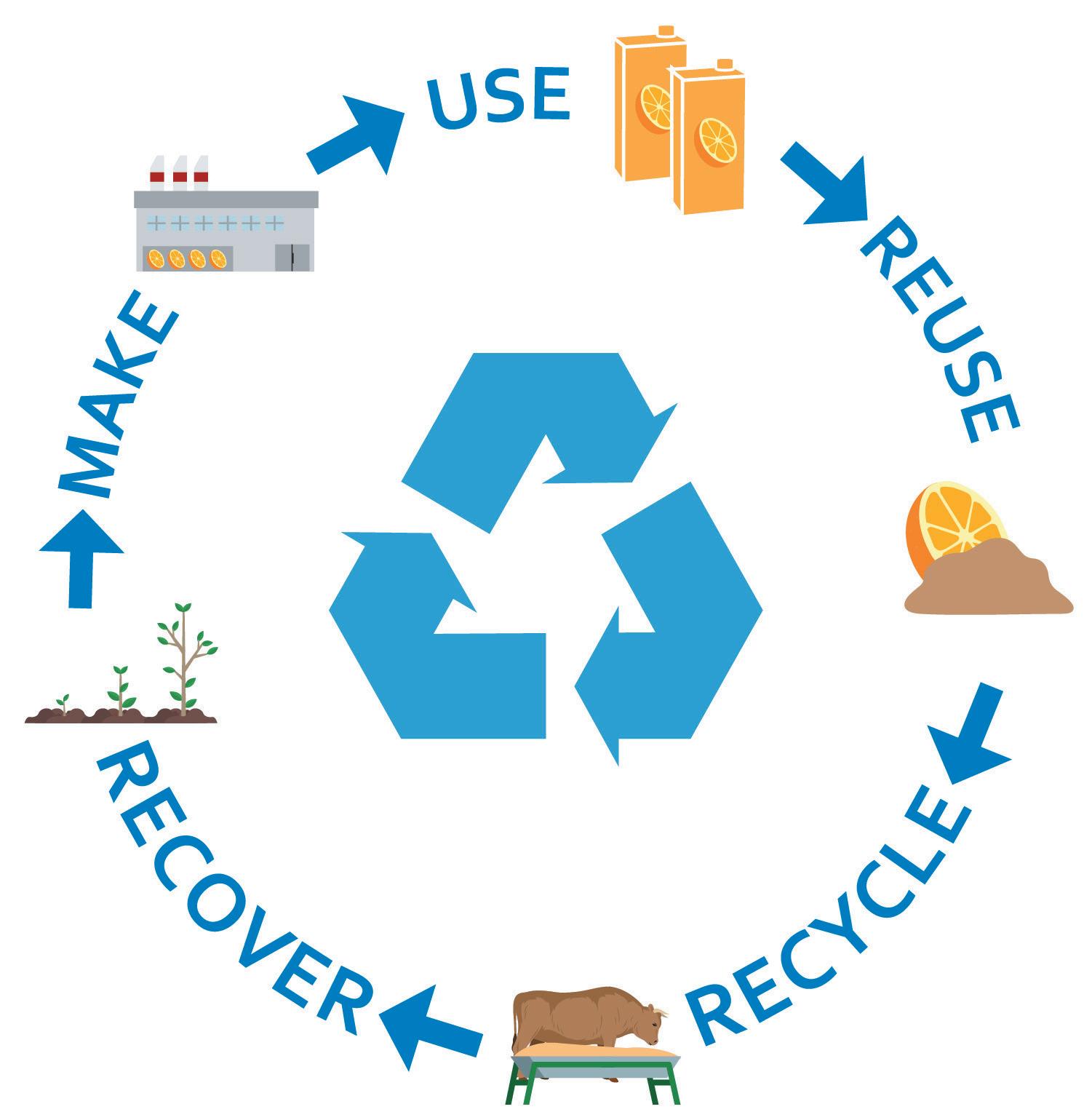
There are also examples of by-products where the materials destined for feed represent a smaller biophysical share compared to the main product, usually destined for human consumption. Wheat bran remains from bread production and brewers’ grains, and yeasts are left over from beer production. Many people are unaware of the by-products resulting from palm oil production that have a useful purpose in animal nutrition, namely palm kernel meal and palm fatty acid distillates.
There are also examples in the slaughtering process of animal carcasses. Because of dietary preferences, a proportion of nutritious and safe animal protein is not destined for human consumption. In meat production, the processed animal protein resulting from the rendering process is a highly digestible protein source, which is very suitable for animal nutrition. In fish processing sites, trimmings remain, which are suitable for carnivorous fish species raised in aquaculture.
Another important diversion to animal food is surplus food, which is sometimes referred to as “former foodstuffs.” These are foodstuffs clearly intended for human consumption, but due to a production error are no longer considered suitable. Examples include bread, cookies, breakfast cereals and confectionery. The use of these materials in feed is the most direct contribution of feed production to food waste prevention, as these products obtained a food status and are not downgraded to waste, thanks to their feed use.
Due to the use of food-grade ingredients in this case, former foodstuffs represent a source of high-quality nutrients that in principle are not affordable for the feed production sector. Often these processed former foodstuffs can be found on the feed market as bread meal or cookie meal. The former foodstuff processing sector is increasingly able to source materials beyond their traditional suppliers.
Coproduct and By-product Environmental Benefits ‘Embracing’ livestock sector circularity potential has been

highlighted in platforms of significance, such as the 2021 United Nations Food Systems Summit. The environmental benefits of coproduct and by-product use can be considered from multiple perspectives, each offering insights into the product use impact, though none singularly provide complete insight into the potential value. When used as feed and pet food, coproducts and by-products offer landfill avoidance, material upcycling, reduced environmental footprint, minimised food waste and water recovery. However, while the benefit concepts are identified, benefit quantification is limited. The following offers examples of quantified environmental benefits.
Ondarza and Tricarico6 recently assessed methane emissions from human-inedible, coproduct and by-product feeds based on product type and use within U.S. dairy cattle rations. Accounting for both enteric and manurebased methane production, by-product and coproduct use generated significantly lower emissions than if the material had instead gone to a landfill, 68 versus 3,448 CO2equivalent, g/kg product dry matter. A similar quantification can be made across the U.S. feed supply chain. Each year, U.S. domestic livestock consume 258 million tonnes of feed and approximately 40 percent of those ingredients are upcycled from other industries.7 Because of its use as animal feed, 103 million tonnes are diverted from the landfill and 61 million tonnes of CO2-eq loss are avoided.
Rendering is the cooking and drying of meat and/or other animal by-products not used for human consumption in order to recover fats and protein. There are 28.1 million tonnes of materials that can be rendered and produced annually in the U.S. and Canada; without rendering, that volume is sufficient to fill all U.S. landfills in four years.8 In the process of upcycling renderable materials, Gooding9 estimated that the average facility directly emits 20,000 tonnes of CO2 through internal operations and indirectly emits 4,000 tonnes of CO2 via their electrical utility. However, the CO2 emitted through the total direct and indirect emissions is still only 30 percent of the emissions that would result from material decomposition in landfills. Water is also recovered, treated and returned to the environment during rendering. The North American Renderers Association estimates 3.7 billion gallons of clean water are reclaimed and returned to rivers, lakes and streams annually.
The above examples illustrate that for the initial owner of coproducts and by-products, the feed and pet food outlet is more sustainable than alternative disposal options. For a feed manufacturer, the use of coproducts and by-products also offer a more sustainable choice when compared to alternative, land-requiring arable sources. Data from the European Former Foodstuff Processors Association (EFFPA) estimates that the use of 3.5 million tonnes of processed former foodstuffs in European countries is equal to over 400.000 hectares of corn, thereby reducing the pressure feed demand puts on arable land. And those processed former foodstuffs have nutritional qualities that make them a good alternative feed ingredient to arable sources such as corn, wheat or barley.
A study by Giromini et al.10determined that processed former foodstuffs can be considered a “fat-fortified version of common cereal grains” thanks to the generally higher fat content while being comparable in starch content. From a biochemical point of view, lipids contain carbon and hydrogen in a more reduced state compared with other nutrients (e.g., carbohydrates and proteins). The better potential for oxidisation therefore provides a greater energy yield. Given the proven difficulties in handling fats.
and mixing them with other ingredients for the formulation of complete feeds, former foodstuffs represent a valuable processing advantage in compound feed production given that the lipids are already part of the matrix. The previously heat-treated (or cooked) starch can be speculated to be of relatively high digestibility quality, which is of particular interest due to the limited capacity of piglets to digest raw starch.
While the aforementioned data points to the environmental benefit potential of coproduct and by-product use, the data set is limited. As the value of circular economy in food and agricultural systems gains prominence, the quantification of outcomes and impacts must expand.

The circularity of a system is ultimately defined by how completely the loop can be closed. And while it can be helpful to assess the circularity of each input singularly (i.e., flow of a particular material within the system), ultimately all inputs and losses must be considered collectively. Therefore, energy or water requirements needed to upcycle a coproduct or by-product, as well as carbon or nitrogen loss following animal consumption, are as important to assessing the circular economy as tracking the flow of the materials within the system.
Circular economy can be used as a benchmark to measure progress on a scale ranging from linear at one end to perfectly circular at the other. Therefore, we could ask: what is the current degree of circularity and how far could we realistically move toward perfect circularity within any food system? With this as a measure, a ratio (α) of total recovered material to total material demand could be performed where perfect circularity equals one.2
Unfortunately, material “upcycling” (i.e., transforming unwanted by-product into a higher quality or higher valued item) is generally only possible with the addition of energy to the system; therefore, additional questions and metrics should be considered. How much energy is needed to upcycle or restore the material to the desired product, and how does the required energy needed for upcycling compare to obtaining the desired equivalent from a virgin source?2 Cullen proposes, calculating energy considerations (β) as one minus the ratio of energy required to recover or upcycle
material (e.g., coproduct or by-product) to energy required to create an equivalent input from a virgin source, where, again, the resulting value equals one for perfect circularity. For animal feed coproduct and by-product use, this could mean quantifying energy for the virgin-sourced material based on nutritional equivalents from other sources or raw commodities.
Proponents of circular economy do not always consider the energy input needed to sustain circularity, but the benefit of material handling should not be considered without addressing the impact in conjunction with energy. Therefore, cojoining the two means a circularity index could be quantified by multiplying α and β, again where perfect circularity equals one.2
Two other circularity metric considerations include: 1) identifying the number of times a resource is used in a product system along with longevity, the length of time a resource is used, as an indicator of resource efficiency in the circular economy. Where the higher the number the indicators show, the higher the contribution to circularity.11 And 2) accounting for a combination of material mass flow and product utilisation rate, where the greater the material recirculation and higher the utilisation rate of a product, the better the circularity.
Assessing circular economy within food and agricultural systems is challenging because both material and energy flows must be coupled with production, processing, distribution and consumption. 1 The Ellen MacArthur Foundation12 revised methodology for circularity indicators includes considerations for biological based materials, and it acknowledges the challenge associated with ‘material loss’ when typical downstream product recovery (e.g., the recovery of plastic for continued reuse) is not possible in agricultural systems. This complexity inherent to food and agricultural systems deserves additional focus and standardisation to accurately assess their value and benefits.
Recognition
Acceptance
Circularity’s Value Circularity in feed production has clear sustainability merit. It allows for a different kind of resource use, while contributing to food production. In the animal production value chain, the circularity of feed, i.e., the use of coproducts and by-products, deserves to be a key indicator of sustainable feed production.
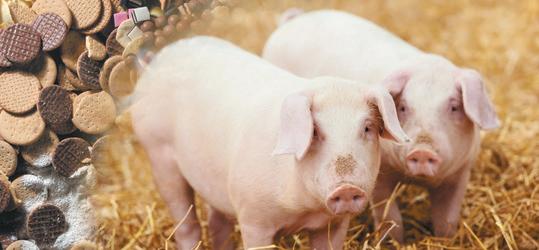
Increasingly, there are production specifications laid down by upstream value chain partners that could restrict feed producers from optimising circularity in feed formulation. A product specification that surfaces and is often part of a claim on the animal product labelling, is the demand for plant-based animal feed. In Europe, market development for animal protein produced with plant-based feed has increased with the reapproval of certain processed animal proteins as feedstuffs. In Europe, former foodstuffs, where often animal by-products, such as milk, eggs or honey, are constituents, are then also excluded. In the U.S., examples have arisen where products labelled as natural beef require vegan-based animal feed sources, thus preventing use of the key coproduct, whey, from milk processing.
The by-products resulting from palm oil production are sometimes even specifically targeted. Due to the negative perception of palm oil, feed manufacturers are sometimes asked to exclude all ‘palm oil products’ from the feed formulation, although it can hardly be argued that the feed use of palm kernel meal or palm fatty acid distillates are a factor of importance for palm tree expansion.
At the same time, food manufacturers themselves are suppliers to the feed industry through the supply of former foodstuffs. In this position as supplier, it is important that a circular economy mentality is adopted. Selling resources to the feed sector should never be seen as a disposal route, but very much the placing on the market of so-called “secondary raw materials.”
Circularity will continue to evolve as an indicator within the broader sustainability discussion. Relative to the biologic, interconnected and complex nature of food and agricultural systems, advancing our ability to measure and assess those systems’ circularity is paramount to gaining sustainability benefits of a circular economy. The use of coproducts and by-products in feed and pet food is just one component of circularity opportunities in food and agricultural systems. As the feed and pet food industry strives to offer and communicate benefits and solutions available to the animal and pet food consumers, the industry must be able to accurately reflect economic and environmental opportunities available through greater circularity. This is important in demonstrating reduced environmental impact as well as need to access and use of currently available ‘waste’ from other industries. Due to the potential scope and scale of system boundaries, the industry would benefit from methodologies capable of assessing the circularity of complex food and agricultural systems. As a methodology for complex biological systems becomes standardised and normalised by use, feedstuff circularity could become commonplace, thereby providing feed manufacturers with a clear incentive to maximise the content of ‘circular feed’ in their formulations.
1. Basso, B., Jones, J., Antle, J., Martinez-Feria, R., Verma, B. Enabling circularity in grain production systems with novel technologies. Agricultural Systems. 193, 103244 (2021)
2. Cullen, J. Circular Economy – theoretical benchmark or perpetual motion machine. Journal of Industrial Ecology. 21 (3) 483-486 (2017)
3. Kirchherr, J., Reike, D., Hekkert, M. Conceptualizing the Circular Economy: an analysis of 114 definitions. Resources, Conservation & Recycling 127, 221-232 (2017).
4. Pauliuk, S. Critical appraisal of the circular economy standard


BS 8001:2017 and a dashboard of quantitative system indicators for its implementation in organizations. Resources, Conservation & Recycling 129, 81-92 (2018)
5. European Feed Manufacturer’s Federation. Resource efficiency champions: co-products, an essential part of animal nutrition. https://fefac.eu/wp-content/uploads/2020/07/05362_coproducts_brochure_003.pdf (2019)
6. de Ondarza, M.B., Tricarico, J.M. Nutritional contributions and non-CO2 greenhouse gas emissions from human-inedible byproduct feeds consumed by dairy cows in the United States. Journal of Cleaner Production 315, 128125 (2021).
7. Institute for Feed Education and Research. Animal feed/food consumption and COVID-19 impact analysis. Prepared by Decision Innovation Solutions. http://ifeeder.org/wp-content/ uploads/210301-FINAL-REPORT-IFEEDER-Animal-Feed-FoodConsumption-COVID-19.pdf (2020)
8. Wilkinson, A.D. and Meeker, D.L. How agriculture rendering supports sustainability and assists livestock’s ability to contribute more than just food. Animal Frontiers 11(2) 24-34 (2021).
9. Gooding, C.H. Data for the carbon footprinting of rendering operations. Journal of Industrial Ecology. 16(2) 223-230 (2012).
10. Giromini, C., Ottoboni, M., Tretola, M., Marchis, D., Gottardo, D., Caparulo, V. Nutritional evaluation of former food products (ex-food) intended for pig nutrition. Food Additives and Contaminants: Part A. 34(8) pp. 1436-1445 (2017).
11. Figge, F., Thorpe, A.S., Givry, P, Canning, L., Franklin-Johnson, E. Longevity and circularity as indicators of eco-efficient resource use in the circular economy. Ecological Economics. 150, 297306 (2018).
12. Ellen MacArthor Foundaton Circularity Indicators: An approach to measuring circularity. https://ellenmacarthurfoundation. org/material-circularity-indicator (2019)
Lara Moody is the executive director for the Institute for Feed Education and Research (IFEEDER), where she provides visionary leadership to the U.S.-based public charity’s activities, including program development, strategic partnerships and collaborative resourcing. Most recently, she has been working to promote awareness of IFEEDER’s Sustainability Road Map project, which will help the U.S. animal food industry lower its environmental footprint and advance industry solutions to the global climate change challenge.

Email: lmoody@afia.org
Anton van den Brink is the senior policy and communication manager for the European Compound Feed & Premixes Association (FEFAC), where he is engaged on sustainabilityrelated topics connected to European compound feed manufacturing, such as responsible soy sourcing, environmental foot printing, circular economy, nutrient efficiency and food waste. He played a leading role developing FEFAC’s Feed Sustainability Charter 2030 and revised Soy Sourcing Guidelines. Van den Brink also serves as executive director of the European Former Foodstuff Processors Association.
Email: avandenbrink@fefac.eu

Outbreaks of emerging zoonotic diseases have increased in the past decade and have affected the population worldwide. Often the blame for such spillover events is put on animals; however, it is humans who have ruined the balance of the ecosystem and exploited flora and fauna for their own gain. The intrusion of humans into wild habitats has increased the human-wild interface thereby increasing the chances of interspecies transmitting diseases in both directions. At the same time, globalisation has increased the likelihood of the rapid dissemination of the infection worldwide. Not wildlife but anthropogenic determinants behind the occurrence of such events should be realised and addressed vehemently.
Millions of years ago when life began on earth, numerous species emerged and co-evolved sharing earth's resources and habitat. Homo sapiens, which evolved as the most intelligent species, dominated and exploited the major share of resources pushing the other species towards extinction or (at the very least) struggling to thrive. Humans expanded their habitat, croplands and livestock into the forests, which disrupted the natural ecosystem and thus ruined the harmonious coexistence with other wild species. Meanwhile, broken barriers by close human-animal interfaces enabled the interspecies transmission of pathogens to distant and diverse species. Incidences of novel pathogen emergence by animal to human transmissions and the extermination of millions of humans from Earth have been witnessed on various occasions. Outbreaks from emerging infectious diseases have been reported to increase every decade since the 1980s and most of them have been linked to wildlife. Increased human-wildlife interactions brought about the recent pandemics of Human Immunodeficiency Virus, Ebola, swine flu, avian influenza, Severe Acute Respiratory Syndrome, Middle East Respiratory Syndrome, Nipah and many more. At this moment during the COVID-19 pandemic, its causative agent (SARS-CoV-2) is found to be closely related to the SARS-like coronavirus in bats1 and we must examine the anthropogenic determinants behind such circumstances, rather than pointing our fingers towards bats or other wildlife species.
In 2019, when the whole world was busy celebrating New Year's Eve, China encountered a cluster of cases suffering from pneumonia detected in Wuhan city and linked its emergence to the Huanan wet market. Taking into account the zoonotic emergence of the disease, Chinese authorities closed those animal markets in the city and reported the incident to the World Health Organization (WHO). Within two months, the disease spread globally and caused more than 200,000 casualties out of more than 3 million cases thus far. Considering the spread and severity of the disease, WHO declared the disease as a pandemic on 11th March, 2020. A pandemic is defined as "an epidemic occurring worldwide, or over a very wide area, crossing international boundaries and usually affecting a large number of people"2. Simply put, it includes widespread diseases causing large-scale morbidity and mortality. Pandemics not only affect public health but also disturb the sociopolitical structure of the countries. The underlying cause reported for the most recent pandemic is the emergence of a new virus or virus strain/ subtype, due to genetic reassortment. These new viruses are
usually highly contagious and after initial transmission from animals readily spread between humans, causing worldwide dissemination. Increased wild-human interface over the past years have increased interspecies transmission of the virus from maintenance hosts to new hosts, seen as a spillover, as well as reverting from spillover hosts to the maintenance hosts, which is known as spillback. These continuous spillover and spillback cycles have expedited the evolution of viruses where wildlife acts as reservoirs together with "living test tubes" facilitating mutation and recombination of the viruses.
Out of more than 1400 documented human pathogens, approximately 61% are considered to be zoonotic. In a study during 2007, Woolhouse and team listed out 87 novel pathogens which were reported to be pathogenic to humans during 1980–2005. Two-thirds of these were viruses and 85% had single-stranded RNA (ssRNA) genomes3. Most of the emerging viruses are ssRNA viruses, which lacks the proofreading capabilities of DNA polymerase or post-replication mismatch repair, leading to the high rate of error during RNA replication which is around 10 times more than DNA viruses. Most RNA viruses are zoonotic in nature as they are capable of a species jump; they were transmitted, at least initially, to humans from non-human mammals or avian hosts. Examples of RNA viruses retaining the capacity to be directly transmitted from animals to humans include influenza, Nipah, and SARS viruses, but even some viruses commonly transmitted exclusively between humans, such as HIV and hepatitis C, likely have animal origins.
Usually the interactions between wildlife and humans take place in two ways, either by the encroachment of their habitat by the human, or having an interest in wildlife tourism, souvenirs and exotic pets. The expanding human population compels intrusion of forests for human habitation, destroying wild habitats which leave wild animals concentrated in a smaller area facing a shortage of food. The dense population of wild animals in a limited area facilitates the interspecies transmission and maintenance of pathogens. Nutrient deficiency and low immunity due to food scarcity further contribute to the proliferation of the pathogens in reservoir hosts. Shortage of food pulls wildlife towards abundant food supply near human habitation bringing wildlife, livestock and human in close contact, which consequently provides a highly conducive environment for the spillover of the pathogens. An appropriate example to be cited here is, during 1998, deforestation and intensive farming of fruit trees with pig farming brought bats near fruit trees, shedding the virus to pigs through partially-eaten fruit droppings4. Similarly, human immunodeficiency viruses HIV1 and HIV-2 are closely related to the simian immunodeficiency virus which was spilled over to humans by coming into contact with SIV-infected non-human primates during hunting and butchering5. A fancy for wildlife fur, leather, ivory and souvenirs, as well as beliefs in traditional medicines, had served as a ground for an illegal yet highly lucrative trade in wildlife, worldwide. These trade industries are known to introduce pathogens to new places along with the introduction of exotic animals and their body parts. The outbreak of monkeypox in the USA, in 2003, is a good example, where prairie dogs introduced the disease into Midwestern states of the US, by acquiring the infection from infected Gambian rats in transportation6. The first incidence of Marburg haemorrhagic fever was observed in the researchers of Germany in 1967, which were exposed to African green monkeys or their tissues imported


Peer Reviewed, IPI looks into the best practice in outsourcing management for the Pharmaceutical and BioPharmaceutical industry.
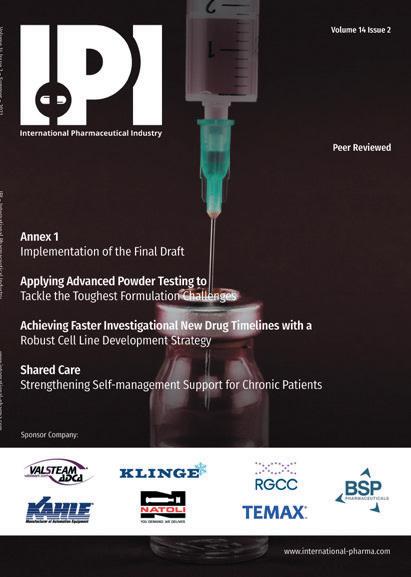
www.international-pharma.com
Peer Reviewed, JCS provides you with the best practice guidelines for conducting global Clinical Trials. JCS is the specialist journal providing you with relevant articles which will help you to navigate emerging markets.

www.journalforclinicalstudies.com
Peer Reviewed, IAHJ looks into the entire outsourcing management of the Veterinary Drug, Veterinary Devices & Animal Food Development Industry.
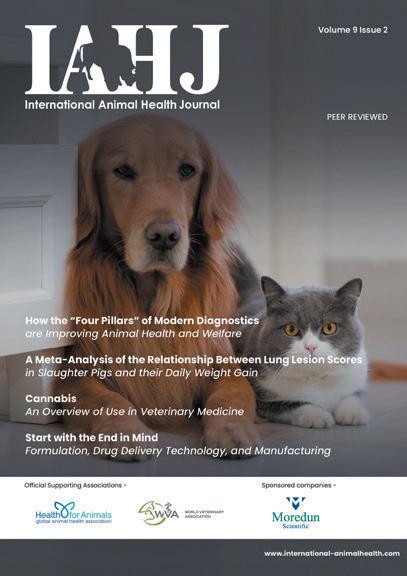
www.international-animalhealth.com
Peer reviewed, IBI provides the biopharmaceutical industry with practical advice on managing bioprocessing and technology, upstream and downstream processing, manufacturing, regulations, formulation, scale-up/technology transfer, drug delivery, analytical testing and more.

www.international-biopharma.com

PNP
Pharma Nature Positive, is a platform for all stakeholders in this industry to influence decision making by regulators, governments, investors and other service providers to achieve Nature Net Positive Results. This journal will enable pharma the ability to choose the right services to attain this goal.

www.pharmanaturepositive.com
Listen to industry experts on the latest in drug discovery, development, research, industry regulations and much more at Pharma,s DNA, the podcast channel by Senglobal Ltd., available on Sound Cloud, Spotify, iTunes and YouTube.

from Africa. Social and traditional values attached to bushmeat consumption make its hunting and trade a million-dollar industry in China and African countries. In the past 20 years, poaching of gorillas for bushmeat has reduced its population to half in forests in the Democratic Republic of Congo. In 1970, the first incidence of monkeypox virus disease to human was linked to non-human primates hunting followed by human-to-human transmission7. The outbreak of Ebola in Gabon in 1995 emerged
from the handling, preparation and consumption of meat from chimpanzees found dead8. Intensely dense live animals’ markets, also known as wet markets, bring different animal species into close contact, where butchering of an infected animal contaminates the environment with blood spills, which thus provide a highly favourable environment for interspecies transmission and mutations of pathogens. Wet markets in Southeast Asian countries had contributed to the emergence and spread of highly pathogenic avian influenza H5N1 in 2006. Outbreaks of Severe Acute Respiratory Syndrome (SARS)9 in 2003 and ongoing COVID-1910 have also been linked to the trade in civet cats and pangolins, respectively, in Chinese wet markets. New trends of captivating wildlife in the name of exotic pets bring human and wild animals under the same roof, increasing the duration of exposure and odds of disease transmission.
Despite the emergence of deadly pandemics with wildhuman interactions, the control measures for minimising human interference are either inadequate or infringed very frequently. Stringent laws on killing, captivity and trade of wild species must be framed and employed rigorously. Preservation of natural habitats of wildlife must be undertaken and injudicious cutting or burning of forests must be prohibited. Human access for livestock grazing, hunting or other recreational activities must be minimised in the buffer zone and strictly restricted in core forest regions. Despite the reports stating wildlife as reservoirs of many pathogens, there is a dearth of monitoring, surveillance and baseline data of diseases in wild animals. Lack of baseline data on disease and population of wildlife in an area render the health authorities incapable of identifying
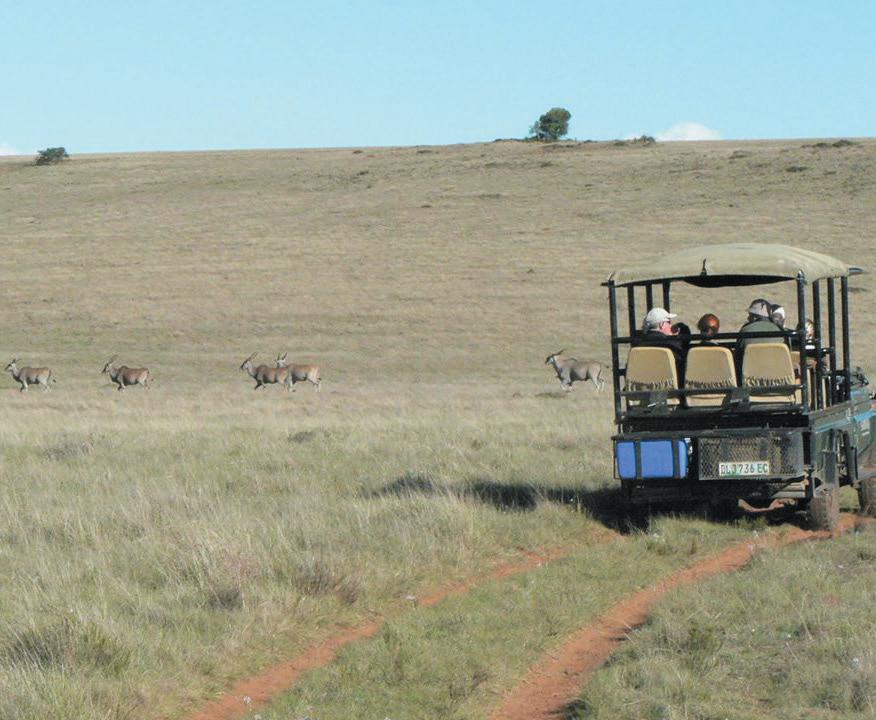

the source of disease. Wildlife surveillance requires a multisectoral approach, including native people, animal health agencies, public health agencies and forest departments. Adequate awareness of people interacting with wildlife is needed to facilitate the monitoring and data gathering. Adequate active and passive surveillance of transmission, carriers and reservoirs of diseases in wildlife is an essential precondition for rapid identification of a spillover. Latest models to predict future spillovers ahead of time must be employed in surveillance studies. Measures like diagnosis, treatment, vector reduction and vaccination in wild animals must be taken to reduce the pathogen load and diminish the likelihood of disease transmission to human.
1. Xu, X., Chen, P., Wang, J., Feng, J., Zhou, H., Li, X., Zhong, W. & Hao, P. Evolution of the novel coronavirus from the ongoing Wuhan outbreak and modeling of its spike protein for risk of human transmission. Science China Life Sciences, 63(3), 457460(2020).
2. Last, J. M., Harris, S. S., Thuriaux, M. C. & Spasoff, R. A. A dictionary of epidemiology. International Epidemiological Association, Inc. (2001).
3. Woolhouse, M. & Gaunt, E. Ecological origins of novel human pathogens. Crit. Rev. Microbiol. 33, 231–242 (2007).

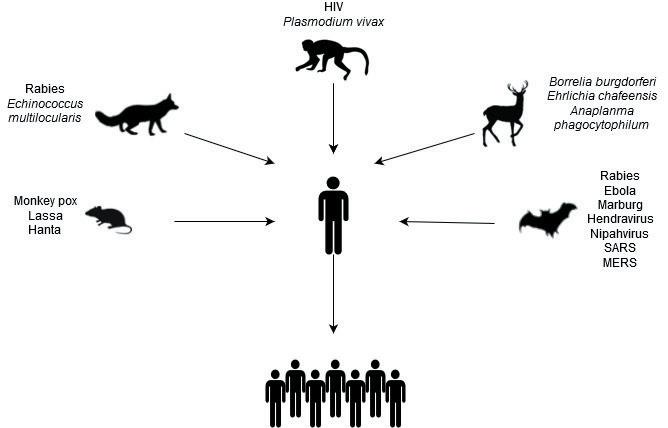
4. Epstein, J. H., Field, H. E., Luby, S., Pulliam, J. R. & Daszak, P. Nipah virus: impact, origins, and causes of emergence. Current Infectious Disease Reports, 8(1), 59-65(2006).
5. Myers, G., MacInnes, K. & Korber, B. The emergence of simian/ human immunodeficiency viruses. AIDS research and human retroviruses, 8(3), 373-386(1992).
6. Centers for Disease Control and Prevention (CDC). Update: multistate outbreak of monkeypox--Illinois, Indiana, Kansas, Missouri, Ohio, and Wisconsin, 2003. MMWR. Morbidity and
mortality weekly report, 52(26), 616 (2003).
7. Jezek, Z., Arita, I., Mutombo, M., Dunn, C., Nakano, J. H. & Szczeniowski, M. Four generations of probable person-toperson transmission of human monkeypox. American journal of epidemiology, 123(6), 1004-1012 (1986).
8. World Health Organization. Outbreak of Ebola haemorrhagic fever in Gabon officially declared over. Weekly Epidemiological Record= Relevéépidémiologiquehebdomadaire, 71(17), 125-126 (1996).
9. Daszak, P., Tabor, G. M., Kilpatrick, A. M., Epstein, J. O. N. & Plowright, R. Conservation medicine and a new agenda for emerging diseases. Annals of the New York Academy of Sciences, 1026(1), 1-11 (2004).
10. Zhang, T., Wu, Q. & Zhang, Z. Probable pangolin origin of SARS-CoV-2 associated with the COVID-19 outbreak. Current Biology (2020).
Hina Malik graduated in Veterinary Medicine and post graduated in Veterinary Public Health. She has been working at the Uttarakhand Animal Husbandry Department as a veterinary clinician for last five years. She is also pursuing a PhD in Veterinary Public Health from the School of Public Health and Zoonoses, Guru Angad Dev Veterinary and Animal Sciences University, Ludhiana, India. Her area of research is Zoonoses and emerging antimicrobial resistance in zoonotic pathogens.
Email: hinamalik.vet@gmail.com




Sterile or standard environments, high-end or routine tasks, Stäubli robots deliver clean, consistent performance ensuring the highest levels of product hygiene, safety, flexibility and productivity. Benefit from our know-how and discover the new automation possibilities of intelligent and safe robot technology.
Stäubli – Experts in Man and Machine
Alltech’s range of feed enzymes was developed to maximize feed efficiency and nutrient absorption — lowering costs and improving bird performance while reducing the environmental impact.
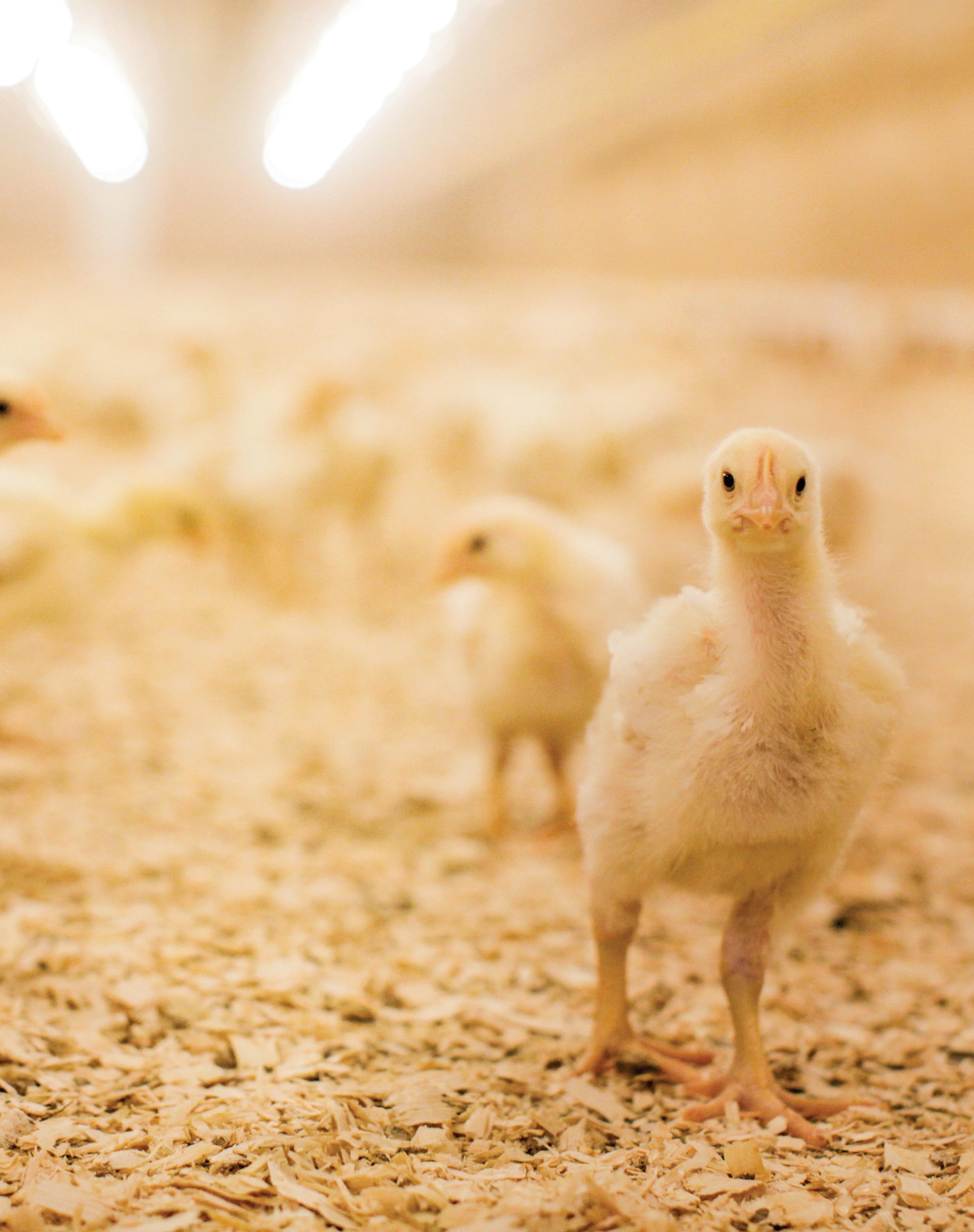
Contact your local representative or scan the QR code below to find out more about our portfolio of enzyme solutions.
Optimizes feed cost savings
Improves nutrient absorption and digestibility
Decreases excess nutrient excretion into the environment